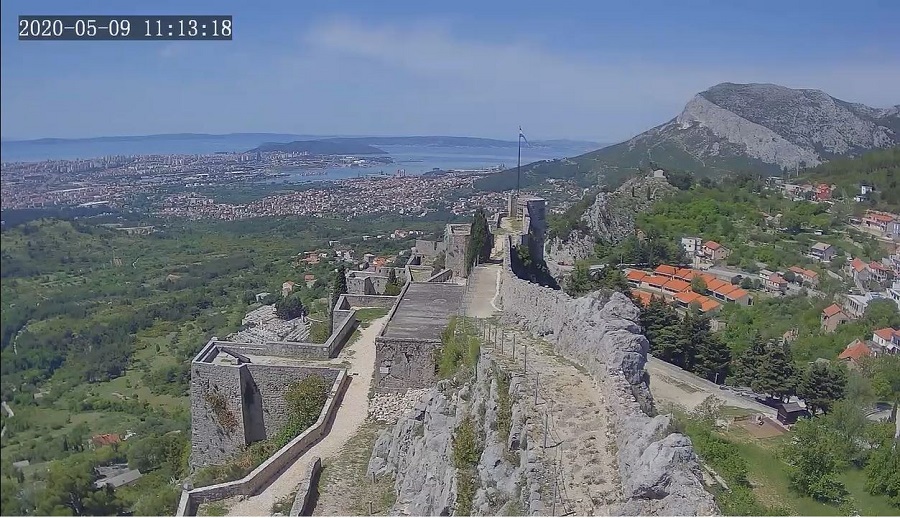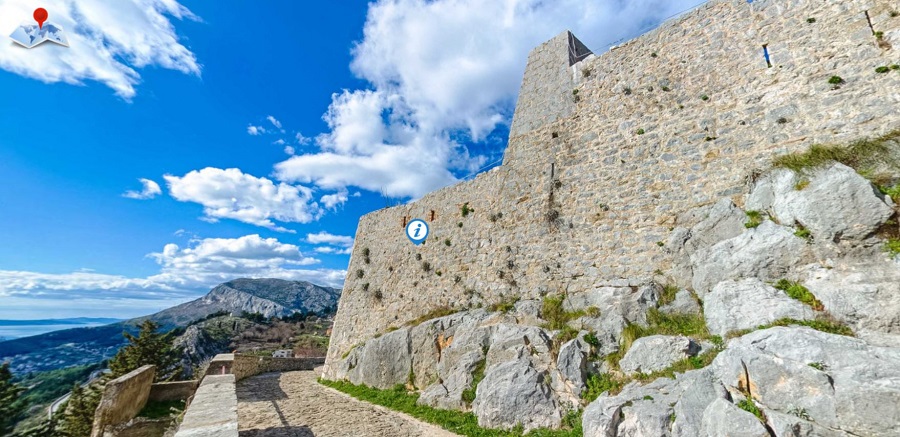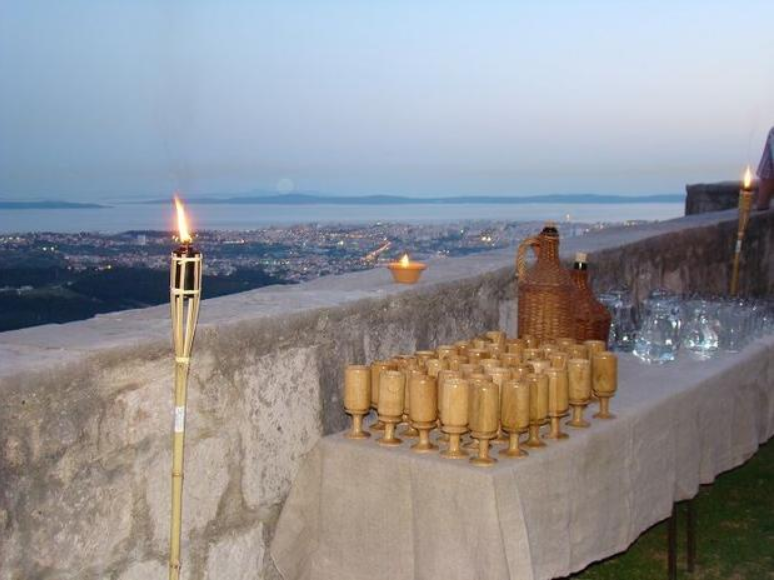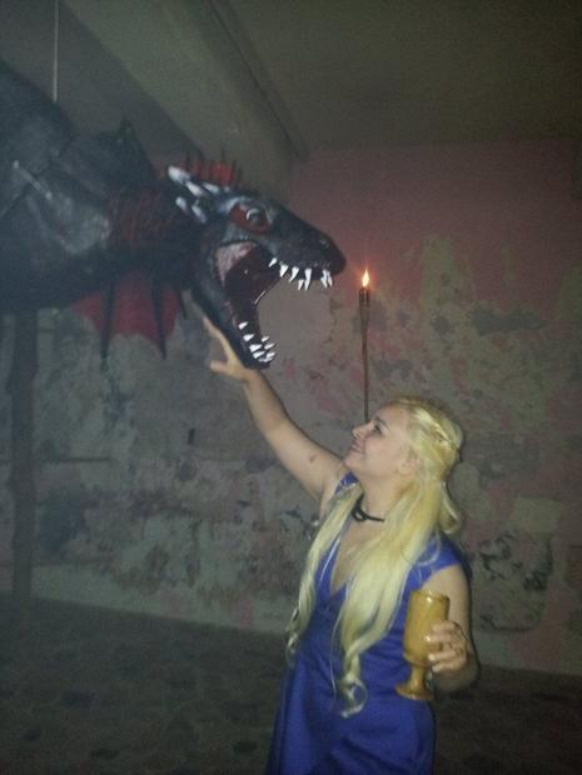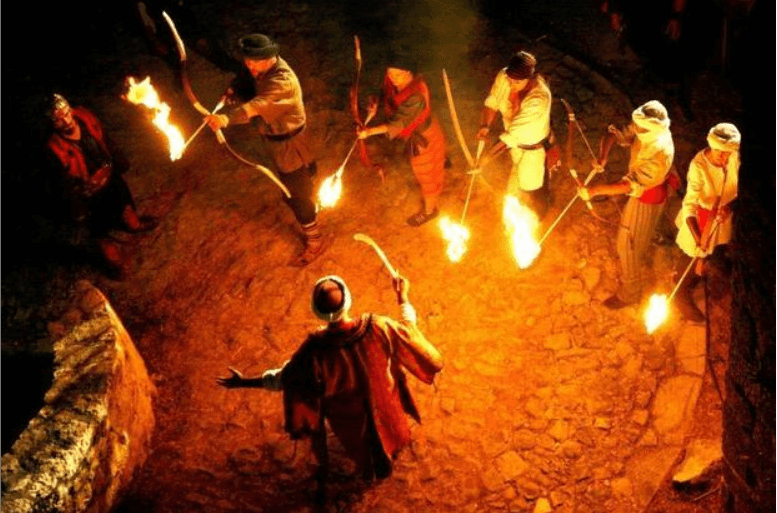Ancient Wells of Rajčica Valley, Inland Dalmatia's Hidden Wonder
February 14th, 2022 - While most tourists tend to gravitate towards the coastline, there are many hidden gems to discover in inland Dalmatia. Meet the wells of Rajčica valley, a magical place that looks as if it came straight out of a fantasy novel
Less than an hour’s drive from Split, in the rugged karst landscape of the Klis hinterland, you’ll stumble upon an extraordinary site. Known as Rajčica, the valley near Nisko village is home to a cluster of 10 ancient wells.
And when we say ancient, it’s actually a bit hard to pinpoint the moment in time when the wells were built. They are commonly referred to as Roman wells, some believe they're from the Illyrian times, and it’s also said they date to late Middle ages, namely the 13th or 14th centuries.
Whatever the case, there’s a certain mystical quality to the picturesque site; it appears to be timeless. The wells are all alike in size and design; they’re closely spaced, each encircled by a dry stone wall and fitted with stone steps descending to the water surface.
Three of the ten wells are shrouded by greenery and have a lower water level, making them somewhat harder to spot. Since the site is located in a valley, heavy rain will often leave the area flooded; during summer droughts, the water level drops.
It’s unknown whether there are any underground rivers in the area, or if the wells are mainly getting water from precipitation. Nestled among the wells is a small pond where the cattle roaming the area often comes to drink.
The name of this wondrous site is another mystery that remains unsolved. Why Rajčica valley? The name literally translates to tomato in Croatian, but it’s believed to be more likely to refer to the place being a paradise in nature (raj = paradise, heaven). Finally, there are sources that claim the toponym originates from a family name that had a historical presence in the area (the valley of the Rajčić).
The wells of Rajčica used to be a seldom visited site, hidden away in a somewhat inaccessible location where one would have to fight their way through the thicket to get to the untouched clearing.
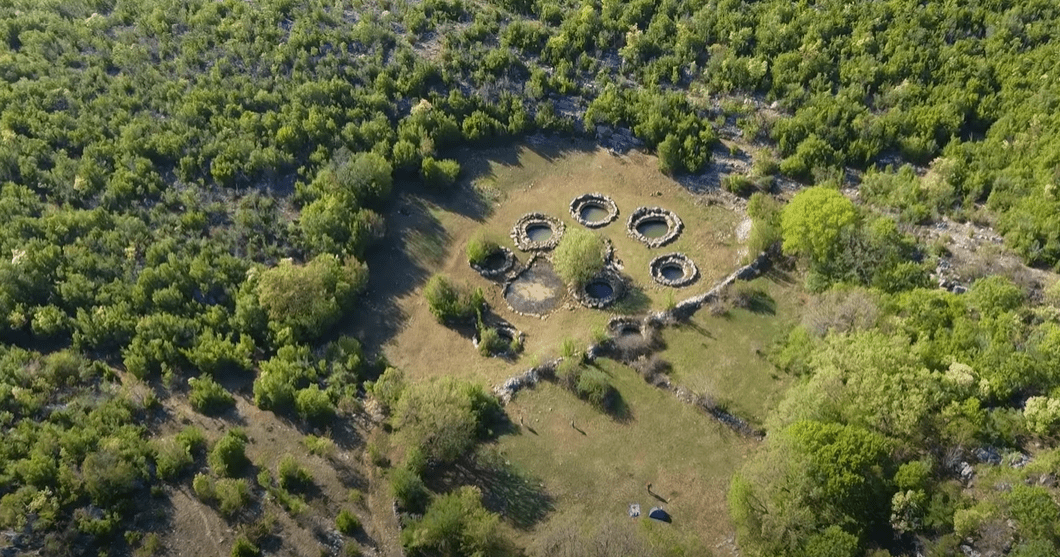
Rajcica valley / YouTube screenshot
These days, it’s more visitor-friendly. Backed by EU funding, Klis Municipality first had a forest road restored that connected the nearby villages of Brštanovo, Nisko and Matase, and which also doubles as an access road to Rajčica valley.
In a more recent part of the project, they had a picnic site built near the ancient wells. As of late 2021, there are seating areas, a grill, and even a balota rink as a nod to one of Dalmatia’s favourite pastimes.
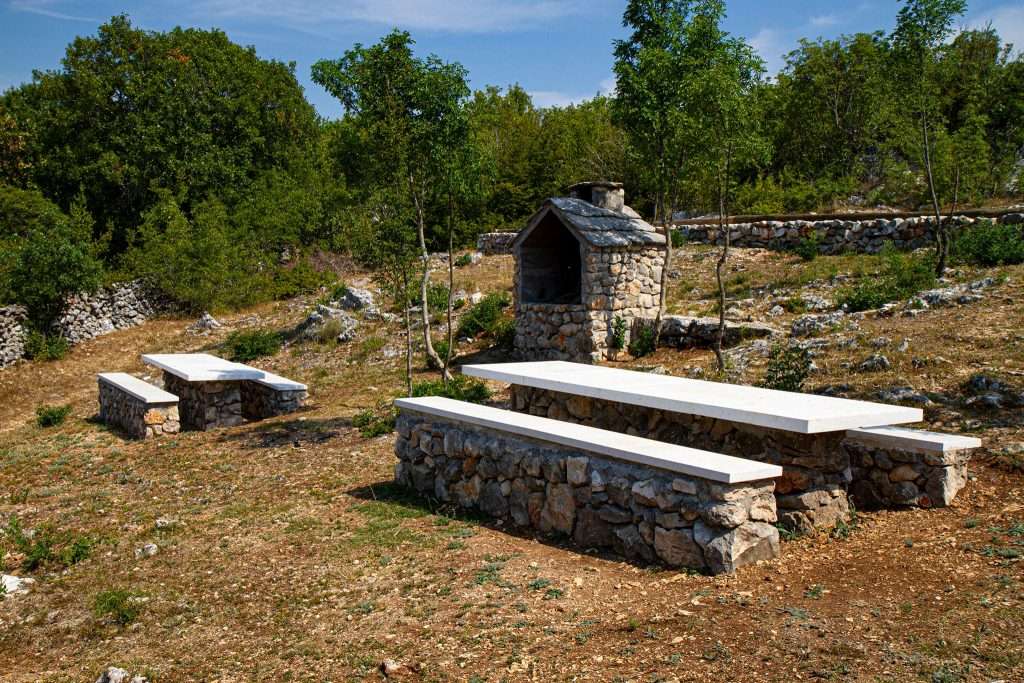 Picnic area / klis.hr
Picnic area / klis.hr
Rajčica valley gained in popularity since it was touched up a bit, especially as the pandemic drove more people to forgo urban destinations and spend time in nature instead. It’s not overcrowded yet, so if you happen to be looking for trip ideas, it just might be the perfect moment to visit the mystical wells before they become too popular among the locals and tourists alike.
‘Besides, the Food Is Very Good’: Impressions of Croatia in Travel Journals of Yore (II)
February 5, 2022 - In the second part of the feature exploring impressions of Croatia found in old travel journals, we're retracing the steps of several foreign visitors in Dalmatia.
If you haven't read the first part, please head here to meet our protagonists, fearless adventurers and diligent reviewers, and see what they thought of Istria. We’re picking up where we left off, with all of our esteemed travellers heading further south.
First up, Zadar, the main Venetian base on the Croatian coast back in the day and thus an obligatory stop on every tour of the Adriatic. Very well defined in this succinct statement by archaeologist Jacob Spon who travelled in Dalmatia in 1675:
It’s the capital and one of the best places that the Republic owns in Dalmatia.
He also liked the cathedral and excellent paintings of Titian and Palma displayed in the churches of Zadar, but I’ll spare you the rest of the paragraph as it’s not more than a list of artworks.
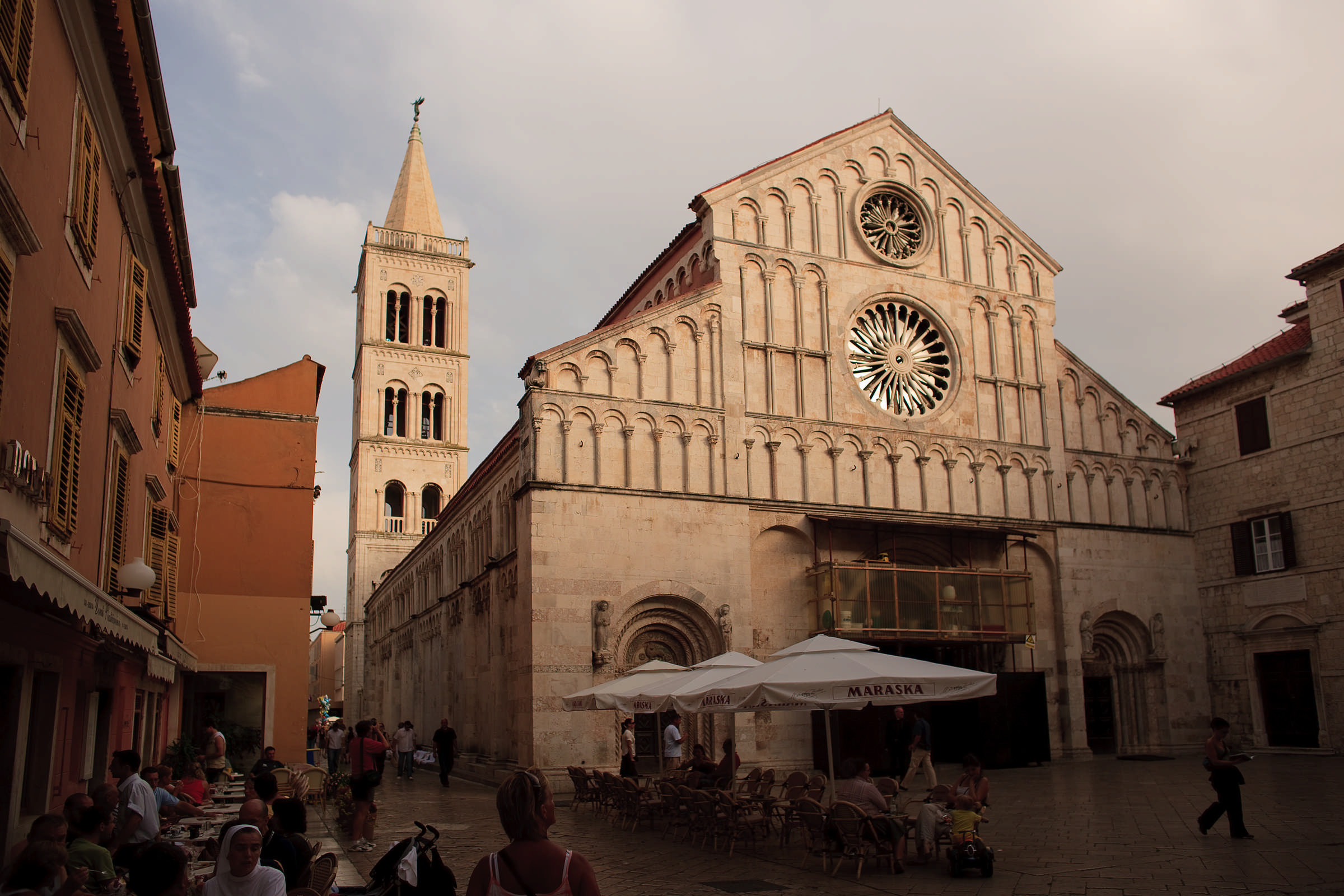 Zadar cathedral by Romulic
Zadar cathedral by Romulic
A few thoughts on Zadar by Noé Bianchi who visited in the 1770s, in his trademark enumeration style:
The city has six gates, a great Arsenal, and many ships and boats. It is a beautiful port, and a place to live in abundance; its territory spans over thirty miles on the mainland, with many castles, islands, and more than four hundred reefs. There are large pastures with plenty of livestock, and an abundance of all sorts of fish; they dress pompously, are very devoted to arms, but above all to humanist studies; they have many schoolmasters, and a lot of merchants.
Let’s hope it was the people of Zadar who dressed pompously and not the fish. Thankfully, we have a new character in our story: countess de La Morinière de La Rochecantin who offers her view of the locals, having visited Zadar in 1907:
The men are not handsome at all; their eyes are hard, their facial features sharp. The women, on the other hand, have a beautiful smile and something seductive under those colourful scarves with which they cover their heads.
Sorry, men of Zadar.
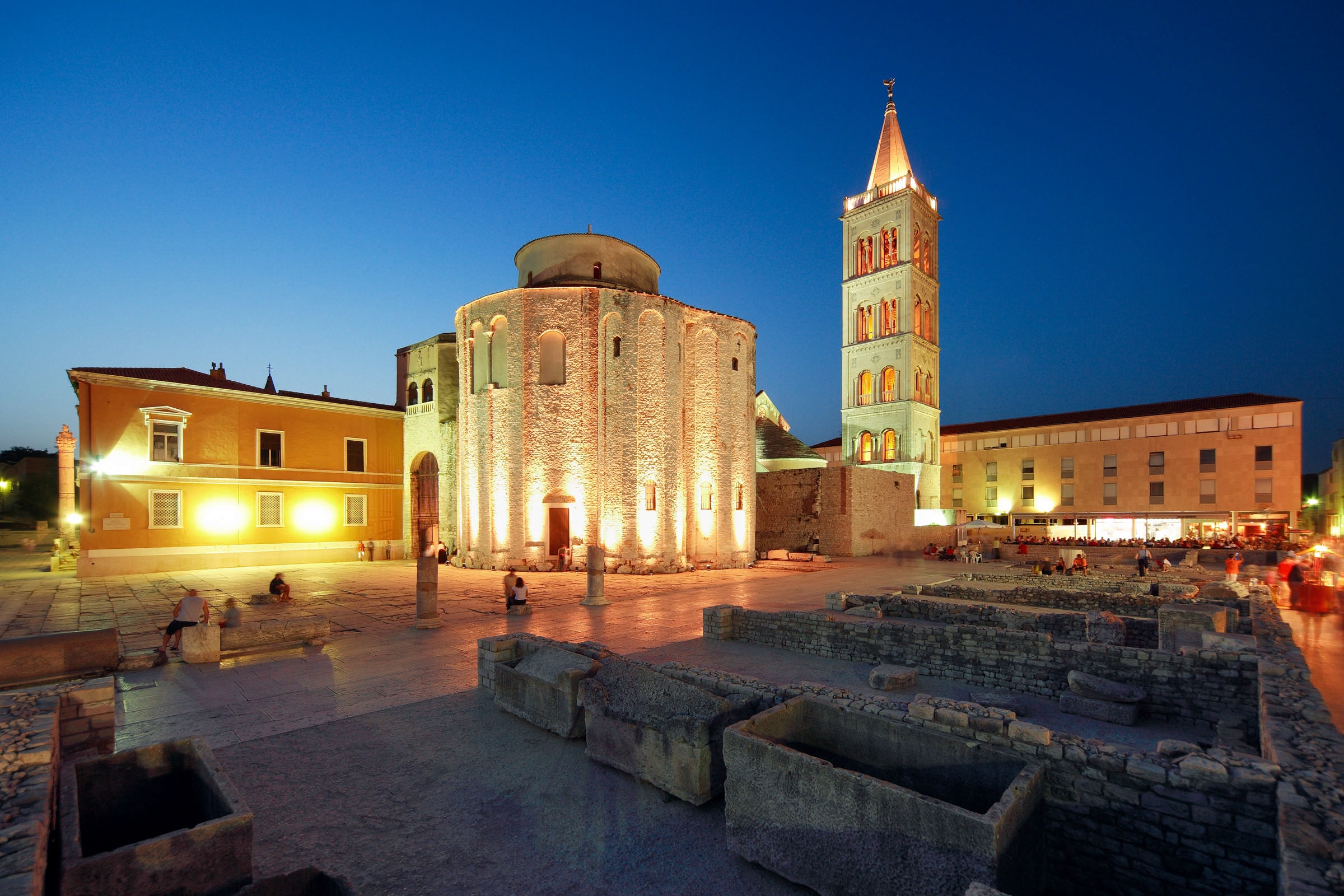 Zadar by Romulic
Zadar by Romulic
***
On we go to Trogir, where the countess notes the following:
The inhabitants are largely similar to those of the Illyrian islands, but this lot is more gentle. They live here in a small Provence. Tamarisk trees and pines, through which a soft wind whistles as if in song, line the narrow paths that run along the shore.
This morning, the water glistens with opal reflections, the air is gentle and warm, but it’s enough for the sky to get veiled in clouds for a feeling of melancholy to take hold of us. In these countries where the sun is king, it alone gives life to beings and things: aromatic plants, trees with pale foliage; the flora of such ardent regions only comes alive and reveals all its splendour and perfumes in the light and under the scorch of the sparkling star.
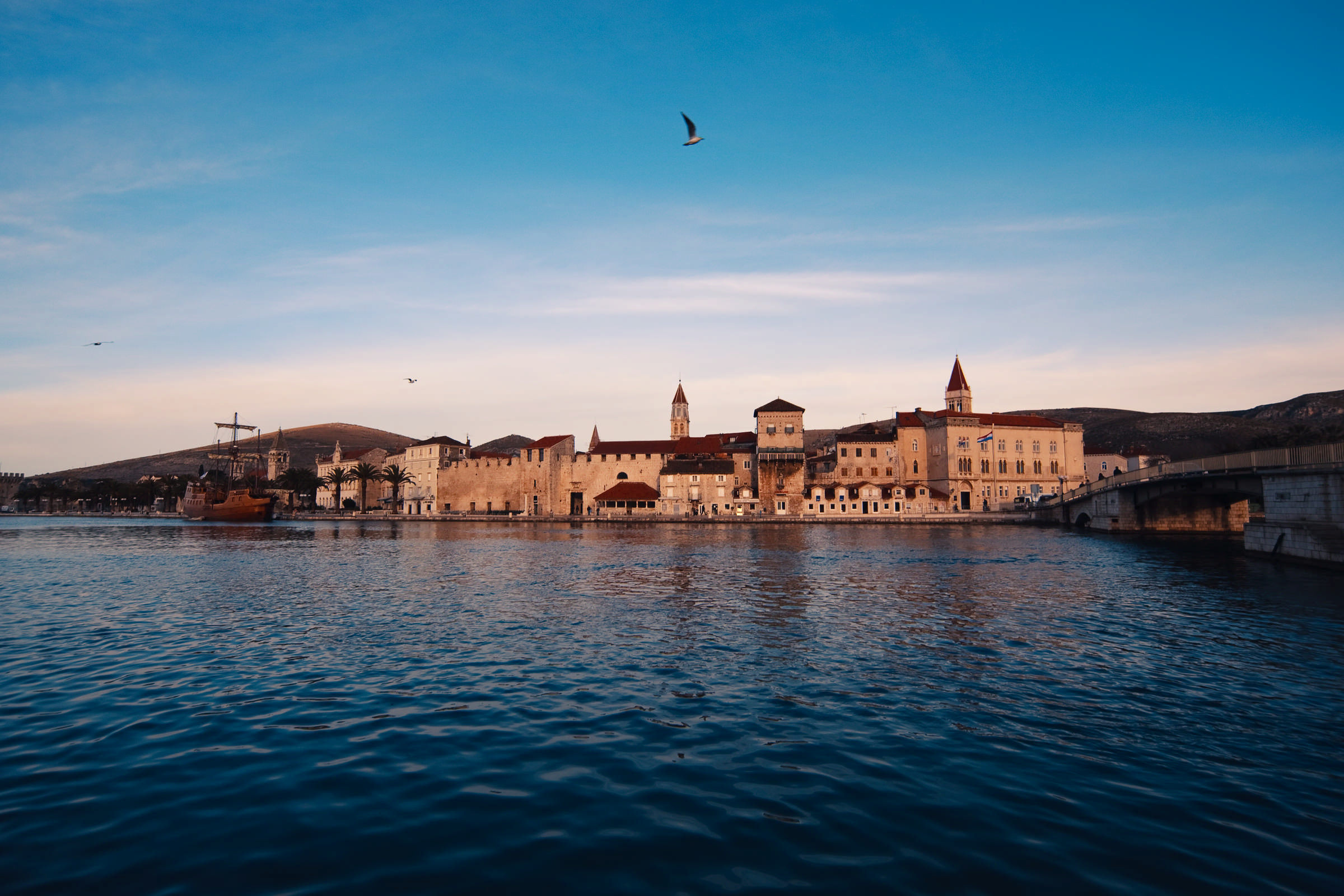 Trogir by Mario Romulic
Trogir by Mario Romulic
Spon on the other hand has a less poetic approach and seems to be excited about Trogir mostly due to it being the birthplace of Ivan Lučić Lucius, a Croatian historian of international renown.
Lucius is known as the father of Croatian historiography owing to his work 'On the Kingdom of Dalmatia and Croatia', in which he gives a comprehensive account of Dalmatia’s history from the Roman times to the end of the 15th century. Seemingly enough to merit admiration from monsieur Spon who, as we’ve learned, wasn’t easily impressed:
This monsieur Lucius is a nobleman from this country whom I had the honour to meet in Rome, where he is now residing. His homeland is indebted to him for having pulled it from the shadows of antiquity with the historic account he made.
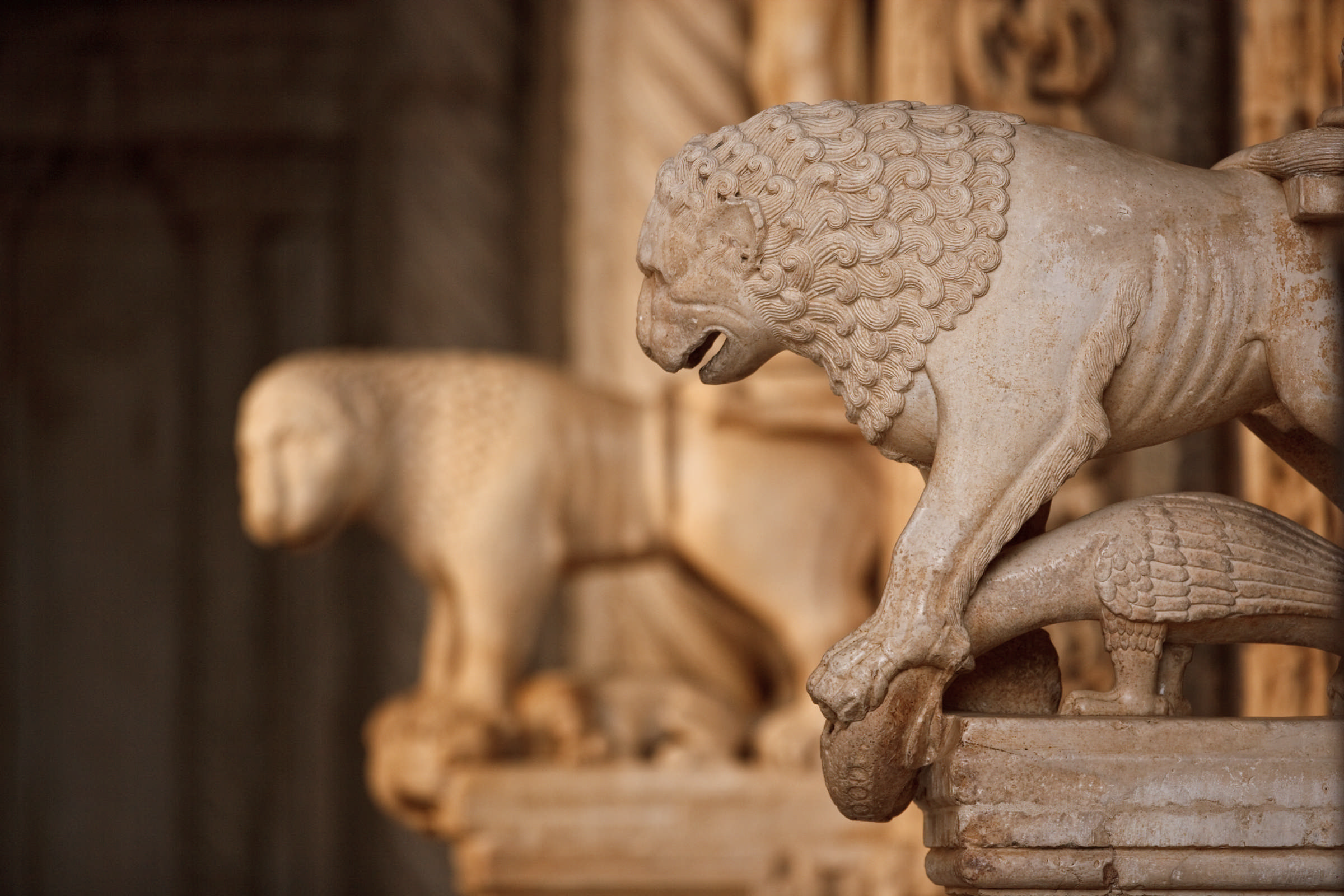 Trogir by Mario Romulic
Trogir by Mario Romulic
Immediately upon arrival, Spon and his party are struck by one of the worst troubles that can happen on a trip: no place to stay!
We had arrived in Trogir at dinner time and were looking for lodging, when we were told that we had to make our own arrangements for dinner, and that it wasn’t customary in that land to deal in hospitality [accommodation].
Naturally, as they were starving at that point, they weren’t exactly happy to hear this, but they got lucky shortly thereafter and found a place in town that sold wine. They were soon ushered into a nearby building that turned out to be none other than Lucius’s palace. This one:
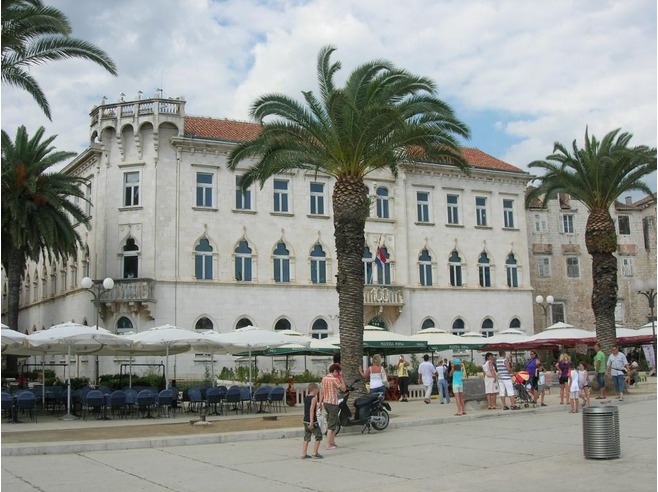
We were surprised to see this house, which is quite beautiful and has a view of the sea, empty and as if deserted, and we were even more surprised when we were told it was the house of this monsieur Lucius whom I just talked about. It has been more than twenty five years since he left it, all because of the incivility of a General of Dalmatia who, having arrived in Trogir, let [Lucius] know he wanted to lodge in his house. The nobleman was getting ready to receive him, and left for himself only a mediocre apartment. But the general immediately sent his people to take all the furniture outside. This impudence annoyed [Lucius] so much, he left the country immediately and never wanted to return.
Loving the gossip. Any thoughts on the sights, though?
The cathedral isn’t ugly. There are some statues in the church, made by a fairly good hand.
Today, the historic centre of Trogir, including the cathedral of St Lawrence, is a UNESCO World Heritage Site.
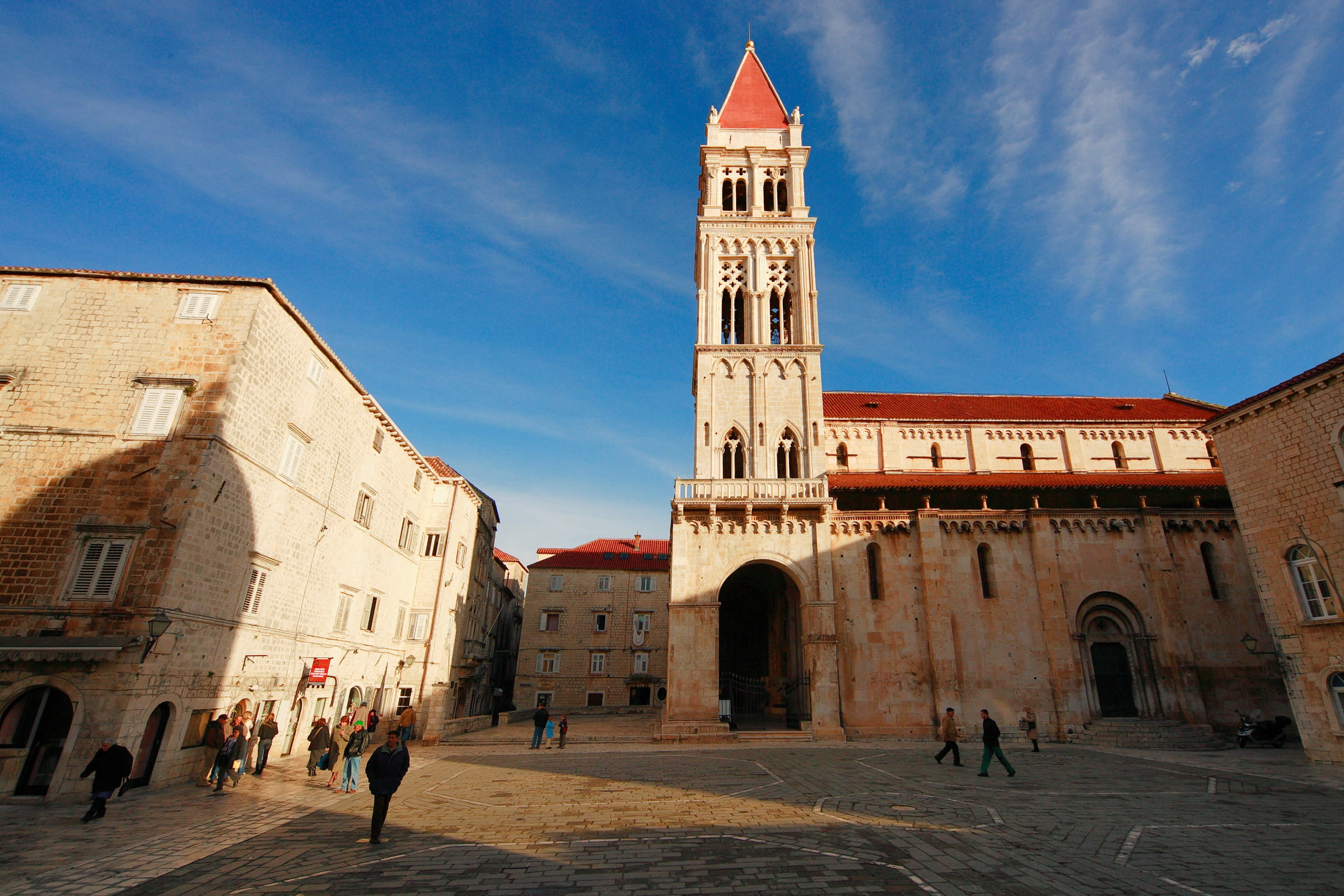 Trogir by Mario Romulic
Trogir by Mario Romulic
We have another appearance by Alberto Fortis who shares a warning: don’t get scammed on your travels! After two pages of musings on marble and its various properties, he says:
As I searched in vain around Trogir to find the famed marble, someone showed up who wanted to abuse my lack of guile by presenting me with a piece of Carrara marble as if it were taken from the nearby hill of St Elijah, where you can find old quarries whose marble isn’t rough at all, but is still far from the refined marble of Carrara.
No one's taking Fortis for a fool!
A traveller must always keep their guard up, as I have, before they draw conclusions based on other people’s claims. I.e., they should go directly to the site in question or at least threaten to do so in spite of all difficulties; that is how you uncover lies.
A marble-related crisis isn’t a situation a lot of us are likely to find ourselves in these days, but fine advice nonetheless.
 The portal of Trogir cathedral by Mario Romulic
The portal of Trogir cathedral by Mario Romulic
He adds a few favourable impressions of Čiovo island:
The island’s climate is truly very pleasant, the air perfect, oil, grapes and fruit excellent, the sea rich in fish, the port spacious and shielded. And its surface isn’t so small that a nobleman couldn’t comfortably walk or ride around it.
Good to know.
***
Before we go on to Split, a note on the hinterland by Marcotti, an Italian writer visiting in the late 1890s:
Those who want to be more in control of their time while travelling in the Dalmatian hinterland will prefer to travel by horse, but will have to get accustomed to a common lack of comfort in regards to accommodation and food: pecorino cheese, stale bread; plum brandy to drink. Corn polenta, ham, roasted lamb, smoked mutton and wine are items of luxury.
***
I believe we’re all familiar enough with the splendour of the Diocletian’s palace in Split to skip the lengthy elegies about its magnificence. Instead, let’s see a few impressions of the town in general, starting with Marcotti:
The market is especially crowded on Monday and Thursday mornings. It is interesting to see how peasants and people from the outskirts of town are dressed: bright colours (blue, red and black), large pieces of jewellery, filigree, gold and silver buttons, chains, medals. Compared with the Morlach women, the women of Kaštela stand out with their elegance.
The countess gets philosophical:
A rosy and curly child, with a serious expression of a grown man, leads us through narrow streets in the ruins of the palace. There is something moving about this loyalty that leads men to live where their ancestors lived, be it within the crumbling walls of an ancient palace or next to a dormant crater that will sooner or later sow devastation and death around it.
![]()
And Spon was surprisingly won over by Split, having spent ten days not doing much other than sampling the local cuisine:
The time we spent in Split did not last us long, because we discovered something new every day and besides, the food was very good. The only downside was accommodation which was not very convenient, as we found but four bare walls.
Partridge only costs five sols there, and hare doesn’t cost much more. There is meat at the butcher’s for one sol a pound, and turtles the size of two fists for four or five sols. But more often than not we preferred to abstain from meat and eat those little trouts from Salona, of which Emperor Diocletian was so fond, that for fear of running out of them he had an express conduit made which brought them to his palace.
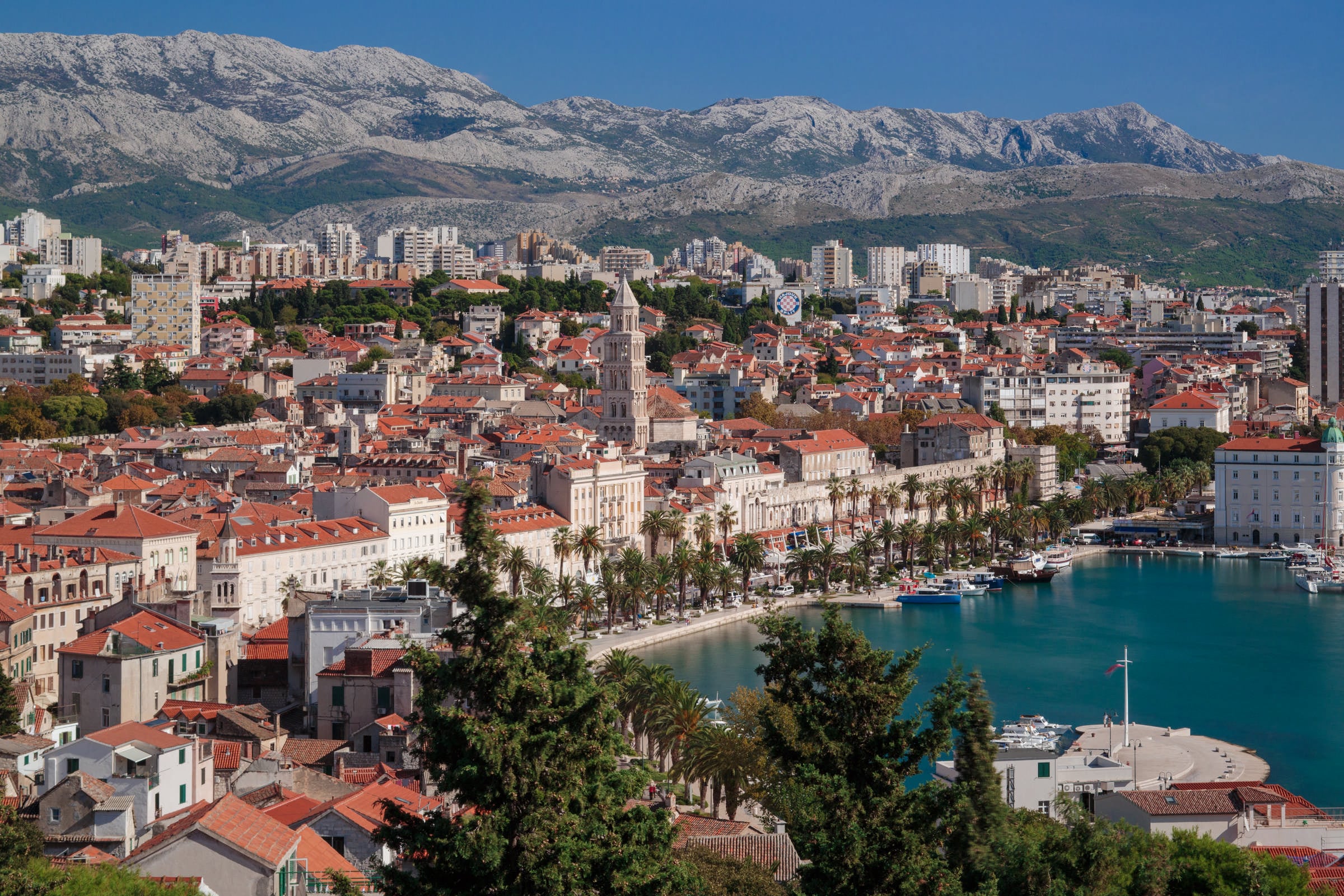 Split by Mario Romulic
Split by Mario Romulic
All of our brave travellers then went to see Klis. Marcotti offers some practical information:
From Split via Klis (2 hours) to Sinj (5 hours), superb road, but the postal service only operates twice a week. A permit from the commander’s office in Split is needed to visit the Klis fortress; it is not granted to ladies.
Rude.
It would take long to recall the whole of its glorious military history, he says about the fortress, then recalls it anyway. A history lesson later, he goes on to say:
The road, the gates, the barracks, they’re all modern; but the walls, the towers, the ramparts, all retain the picturesque charm of ancient military gear: the mosque was transformed into a warehouse. And there’s a beautiful view to boot. In the village, nestled on terraces below the fort, are several taverns.
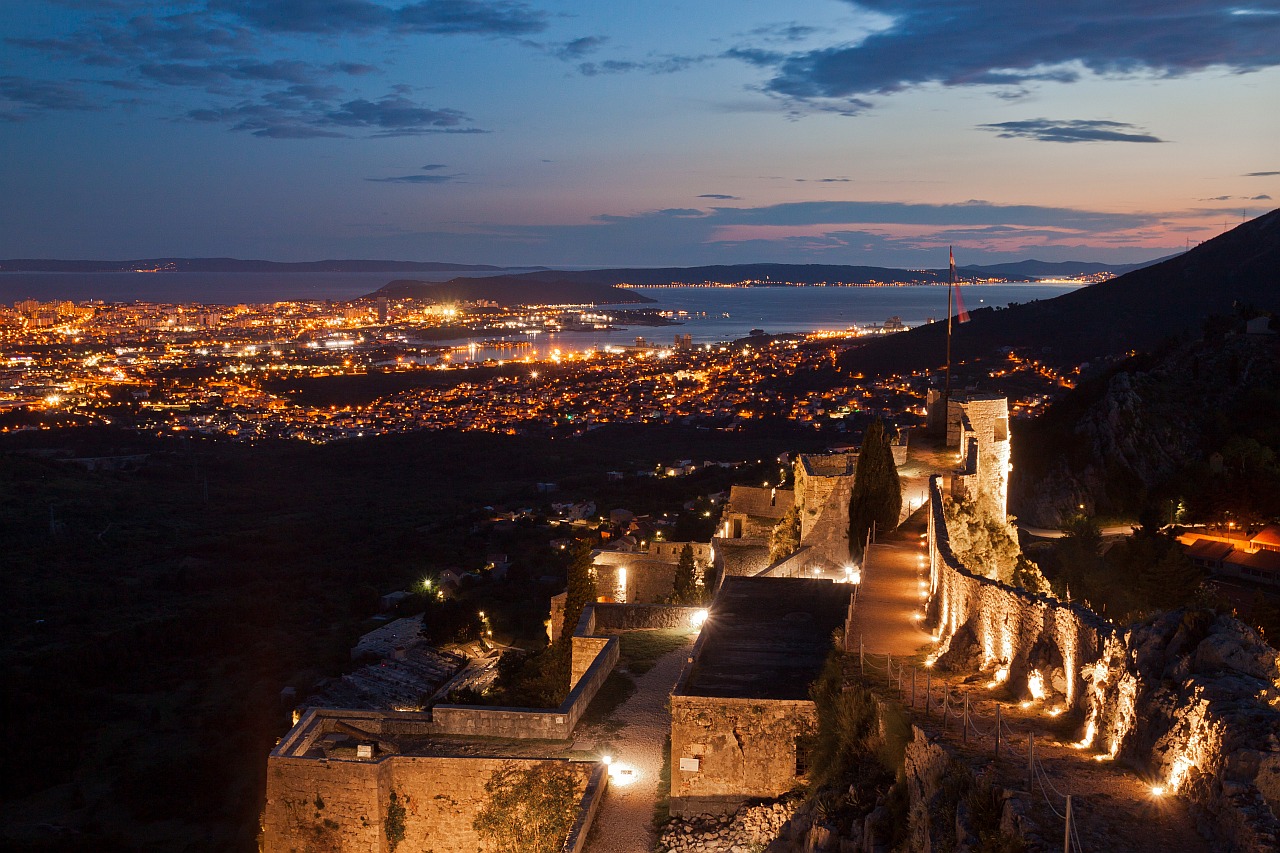 Kliss fortress
Kliss fortress
Countess Rochecantin:
The citadel of Klis, truly an eagle's nest which proudly dominates the valley. The rock it’s built on is surrounded by peaks which would seem inaccessible, if it wasn’t for little pockets of greenery bearing witness to the patient conquest of man over this rugged nature.
And then there’s Spon, bless his heart:
There’s a lack of water and it gets terribly cold in winter. I imagine it’s a harsh penance for a Venetian nobleman to serve here as an officer for two years. 2/10
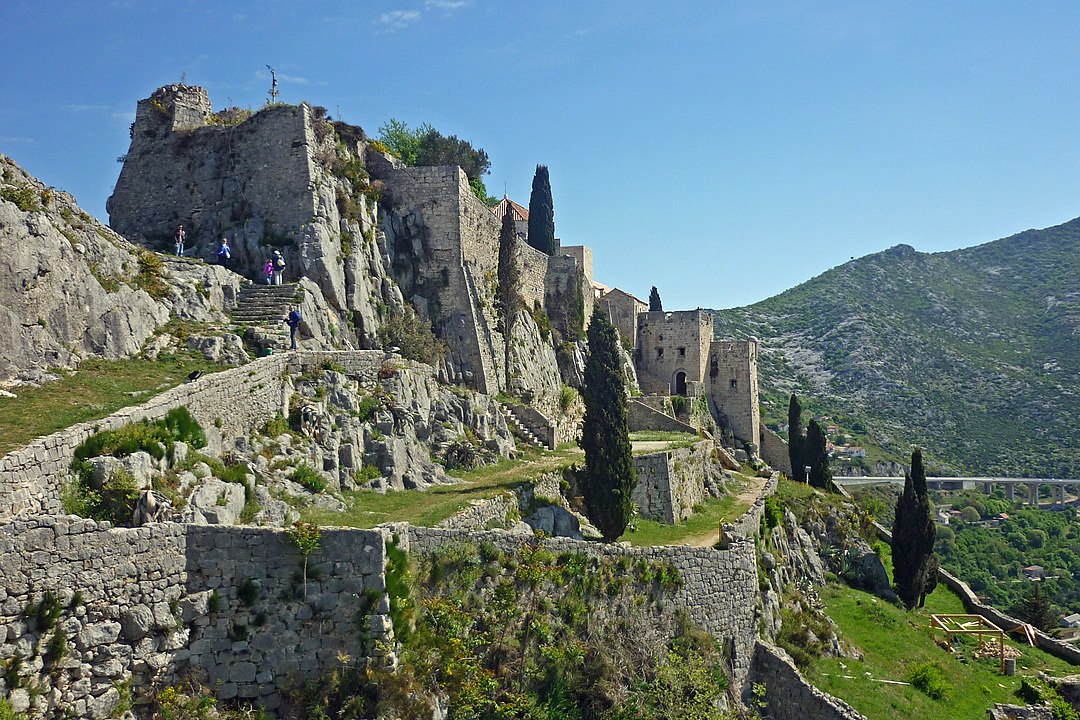 Kliss fortress
Kliss fortress
Marcotti offers a few pointers for towns and islands in the area:
At the mouth of the river Cetina, between Mount Biokovo and the sea is Omiš, a formidable ancient pirate nest. Ruins of the Mirabela and one other castle: excellent wines, pink muscat, even some dessert sparkling wines.
The man truly tells us what we want to know the most.
Šolta isn’t big: its chief town Grohote only has 1200 inhabitants. It’s been renowned for its honey since ancient times; the bees only suckle on rosemary.
Brač is the most important Dalmatian island, in terms of size, population and wealth. They produce vugava, an excellent prošek wine. (...) In the village Pučišće are quarries where stone was sourced for Diocletian’s grand construction in Split.
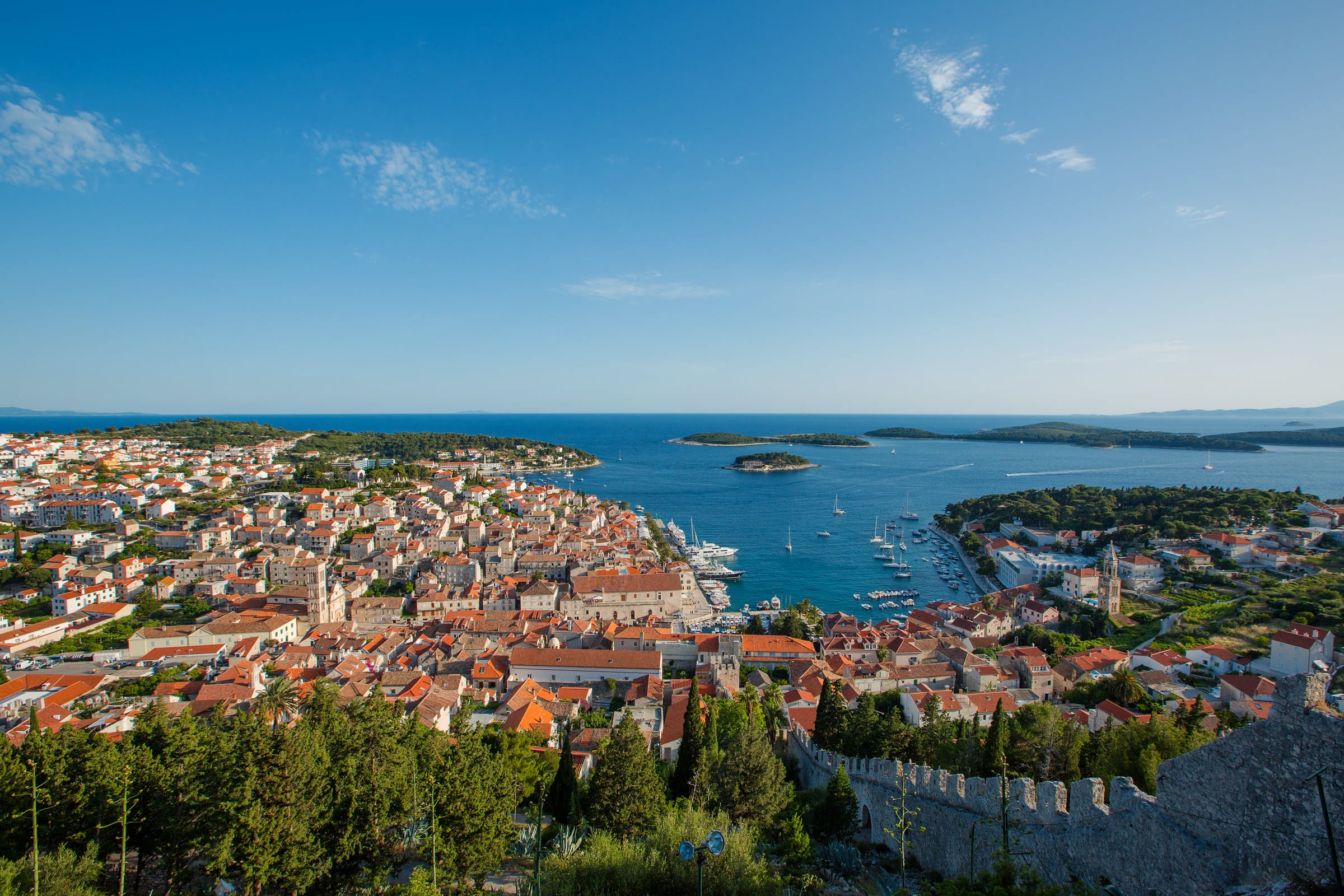 Hvar town by Mario Romulic
Hvar town by Mario Romulic
Hvar: shielded from bura wind by the island’s hills, and from sirocco wind by Pakleni islands, it enjoys a well-deserved reputation as a very favourable climate. Cypress, agave, carob and palm trees thrive there magnificently.
A particular thought stands out in this paragraph. At the time of his visit in the late 19th century, organised tourism was already in development in Croatia, notably in two destinations both mentioned here. Marcotti says:
If direct lines by sea between Italy and Dalmatia were properly established, Hvar town would be a highly recommendable winter destination for the Adriatic regions of the Kingdom, incomparably preferable to Opatija.
According to Spon, Hvar town was an inviting place even two hundred years earlier:
The people of the island, who are three or four thousand in number, have all withdrawn to the town of the same name so they can watch foreigners occasionally dock in their port. So they could receive them with more dignity, they have made there a beautiful pier of marble and stone blocks which lines the semi-circular port.
There is very good bread and very good wine, and plenty of sardines to whet the appetite, with which they also supply Italy and Greece.
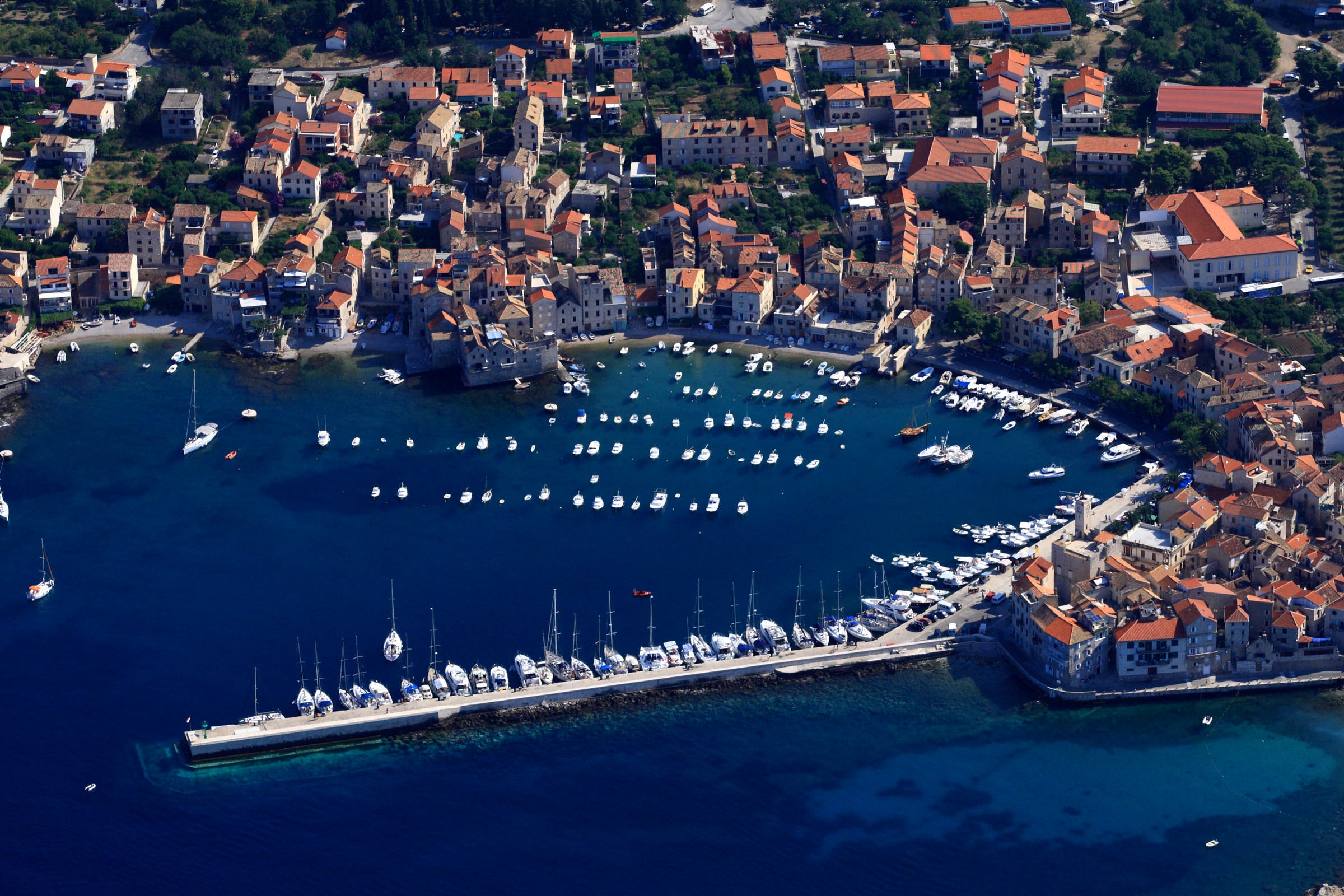 Komiža on Vis island by Mario Romulic
Komiža on Vis island by Mario Romulic
Vis: The island’s vegetation has a distinct southern character, with almond trees, figs, and palm trees. Some excellent wines are the opollo, the Margherita, the prosecco, the gripola, as well as vinegar and brandy. Sardines are abundant in Komiža; anchovies, mackerel, sea bream and snapper are found in all the waters around the island. The suckling lambs are delicious owing to the aromatic pastures of rosemary.
Spon also visited Vis island, but wasn't impressed with the sights:
I won't talk about the fortress, it's just a crow's nest that could be knocked down with ease from the nearby rocks. In the whole garrison there is but one simple soldier who performs the roles of Captain, Sargent and Porter, much like that of Plautus.
He goes to Korčula next, where he learns about jackals:
As this island is covered in woods, it is a haven for several wild beasts. Among them is a certain animal which I am told is built like a dog, but has the cry of a cat or a peacock. If one lights a fire at night near these woods, one can hear a great number of them shrieking and chanting their rabid song, such that those who have never heard them before mistake them for people yelling. It is also said that they dig up the dead to feed on them, and they are good for naught else, but to make some horrid furs out of them.
Next up: Dubrovnik, plus a few places we missed on our way south!
Sources for part II:
Jacob Spon, Voyage de l'Italie, de Dalmatie, de Grece, et du Levant, Fait és années 1675. & 1676., Tome I (Antoine Cellier le fils, Lyon, 1678)
Noé Bianchi, Viaggio da Venezia al S. sepolcro, et al monte Sinai (Remondini, Bassano, 1770)
Giuseppe Marcotti, L’Adriatico Orientale, da Venezia a Corfu (1899)
Alberto Fortis, Viaggio a Dalmazia, 1774 (Croatian edition: Put po Dalmaciji, Globus, Zagreb, 1984)
Comtesse de La Morinière de La Rochecantin, Croisière en Adriatique et en Méditerranée (1907)
Quotes translated from Croatian, Italian and French by the author of the article.
New Klis Fortress Tourist Attraction: Construction of Summer Stage Soon Begins
December 1, 2020 - A new Klis Fortress tourist attraction should hopefully welcome visitors next year - a brand new summer stage.
Dalmatinski Portal reports that the Municipality of Klis announced that the public procurement procedure for the selection of contractors to build a new summer stage at the Klis Fortress is nearing completion, which will further improve the content and offer of cultural events at one of the most important and beautiful fortifications in Europe.
Thanks to the successful withdrawal of European funds, the Municipality of Klis, through the ITU mechanism of the Urban Agglomeration, has provided funds to build and equip a new summer stage at the Klis Fortress. The signing of the contract with the selected contractor is expected in December, and in addition to the summer stage, the reconstruction of the artillery barracks, the rehabilitation of the small quarter, and the protection of the fortress from vegetation are also planned. The project is worth 5.5 million kuna, and 85 percent of its value is funded by the European Union.
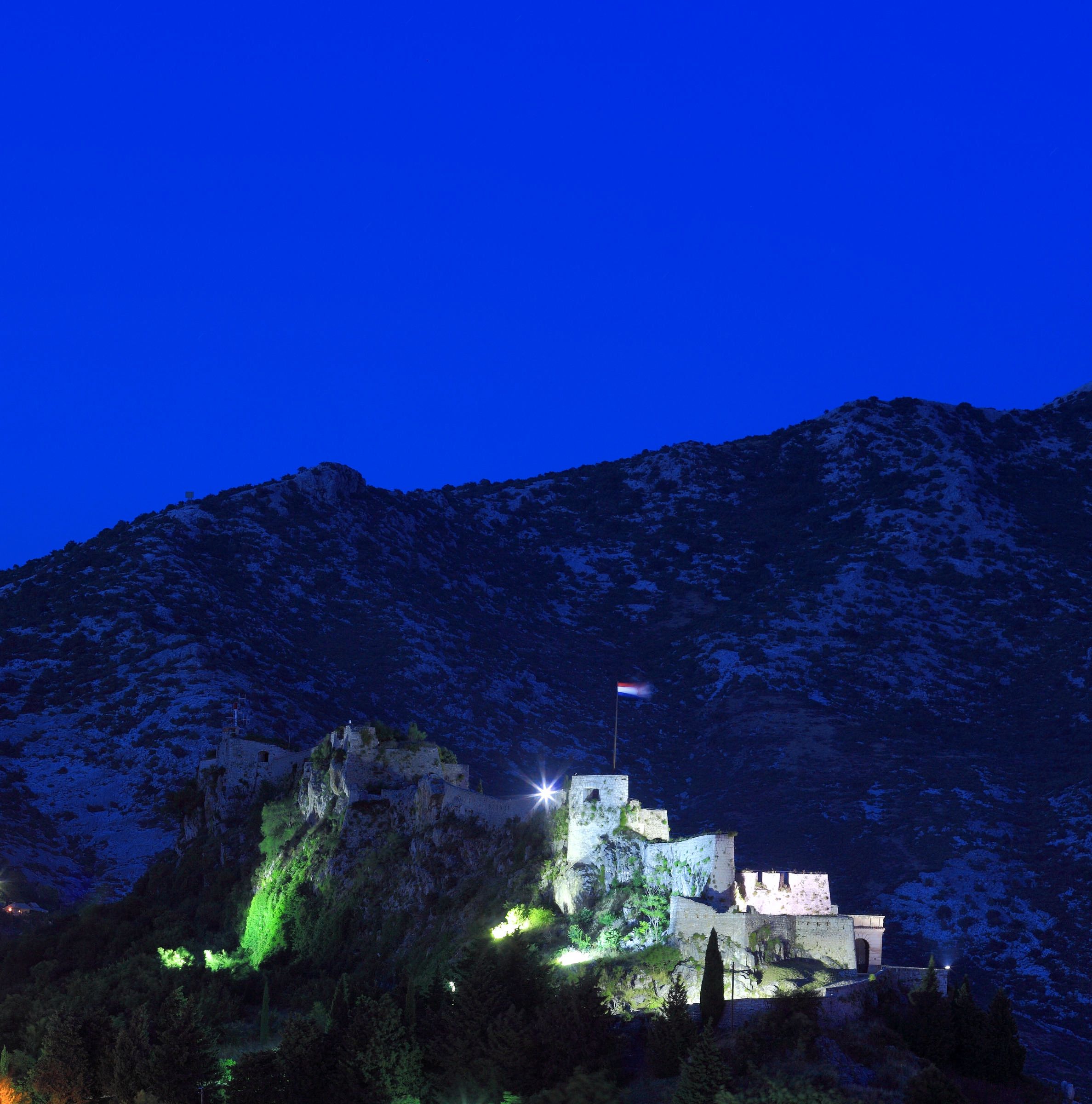
Romulic & Stojcic
"We hope that in the summer, if epidemiological conditions allow, we will be able to watch and listen to the performers of numerous cultural and entertainment events on the new stage, which bring together both domestic and foreign tourists, as well as the locals of Klis. Last year, as many as 100,000 visitors who enjoyed the beauties of this world-famous medieval fortress were exceeded and we are proud to valorize its tourist potential through the sustainable and responsible use of cultural heritage," said Jakov Vetma, Mayor of Klis.
Klis Fortress is one of the most important cultural and historical monuments in Croatia, which in recent years has gained recognition in the world thanks to its role in the HBO's series 'Game of Thrones', which was partly filmed in Klis.
The Municipality of Klis continuously invests significant funds in revitalizing the Fortress and enriching the facilities it offers, thus contributing to the tourist image and offer, not only of the Klis region, but also of the entire region.
To read more about lifestyle in Croatia, follow TCN's dedicated page.
From Trogir to Podstrana, Split to Dicmo: Public Bicycle System to Connect Urban Agglomeration of Split
October 17, 2020 - The cities and the municipalities that make up the urban agglomeration of Split will soon be connected by a public bicycle system.
The project for the development of public bicycle systems in the Urban Agglomeration of Split plans to further popularize the use of bicycles as an alternative form of public transport in the UAS, by developing and improving the cycling infrastructure network that will enable faster access to public transport stops, but also serve as an upgrade and supplementing the existing form of public transport on the daily routes of the inhabitants of the urban agglomeration.
The project is called "Choose a bicycle!", which was applied for co-financing with European Union funds within the ITU Call "URBAN MOBILITY - Development of public bicycle systems in the Urban Agglomeration of Split."
As part of the activities of this integrated project, the City of Split and 7 partners - cities and municipalities from the Urban Agglomeration of Split (Solin, Trogir, Kaštela, Podstrana, Klis, Dugopolje and Dicmo), will receive 41 new stations with a mixed contingent of 242 bicycles and two bicycle roads will be established - in Split (in the area of Trstenik Bay) and Trogir (in the area of Brig-Lokvica). Through project activities, an analytical basis will be prepared - a document for establishing an integrated system of bicycle roads in the Urban Agglomeration of Split, which will be the basis for establishing a planned integrated system of bicycle roads in the Urban Agglomeration of Split.
These 41 new locations with bicycle terminals will be distributed in eight local self-government units per the analysis of needs and possibilities for the implementation of the system, as follows:
City of Split: 16 terminals with 50 electric and 20 classic bicycles;
City of Solin: 6 terminals with 12 electric and 26 classic bicycles;
City of Trogir: 3 terminals with 10 electric and 10 classic bicycles;
City of Kastela: 6 terminals with 30 electric and 30 classic bicycles;
Municipality of Podstrana: 2 terminals with 6 electric and 6 classic bicycles;
Municipality of Klis: 2 terminals with 4 electric and 8 classic bicycles;
Municipality of Dugopolje: 4 terminals with 10 electric and 10 classic bicycles;
Municipality of Dicmo: 2 terminals with 4 electric and 6 classic bicycles.
The project's total value is HRK 13,609,435.83, of which the grant amounts to a total of HRK 10,893,396.68. It is planned that the activities for implementing the public bicycle system will be carried out by June 2021, and the construction and marking of bicycle roads by mid-2022. The project application was prepared by the Development Agency Split - RaST d.o.o., with the support of the Service for International and EU Projects of the City of Split.
For the latest travel info, bookmark our main travel info article, which is updated daily.
Read the Croatian Travel Update in your language - now available in 24 languages.
Tourism in the Corona Age: 10 Virtual Ways to Discover Klis
May 8, 2020 - Tourism is on hold, but most of us have plenty of time. So let's look at the virtual resources available to explore Croatia virtually. We continue our new Virtual Croatia series with the tools to discover Klis.
A few weeks ago I wrote that being a tourism blogger in the corona era was about as useful as being a cocktail barman in Saudi Arabia. I feel less useless now, a few weeks later, and I am encouraged by the number of Croatian tourism businesses who are contacting us wanting to start thinking of promoting post-corona tourism.
One of the challenges of writing about tourism at the moment is that there is nothing positive to write about. With people confined to their homes and tourism in Croatia currently not possible, many have decided to go into hibernation until it is all over.
I think that this is a mistake, and I have greatly enjoyed the TCN series by Zoran Pejovic of Paradox Hospitality on thinking ahead to tourism in a post-corona world. You can find Zoran's articles here.
Way back on March 14 - several lifetimes ago - I published an article called Tourism in the Corona Age: 10 Virtual Ways to Discover Zagreb. The way I saw things, now was an OUTSTANDING opportunity for tourism promotion. People have time, they yearn for their freedom and former lives, so give them the tools to thoroughly research and enjoy your destinations, and you will have then longing to be there. And when they do come, they will have a deeper understanding of the destination due to their research.
South Africa and Portugal were the first to do their post-corona tourism promotion videos several weeks ago (Post-Corona Tourism Planning: Lessons from South Africa and Portugal), a trick which has been followed by other tourism countries, the latest being Croatia with the national tourist board campaign, #CroatiaLongDistanceLove, going live yesterday.
But while these campaigns create longing and market presence, they don't really educate. People now have time to really get into destinations. And dreams of escape to somewhere more exotic are high on the list of priorities of many.
So TCN has decided to help with that education with a new series called Virtual Croatia, where we will be helping you discover many of Croatia's destinations with all the best virtual tools available on your self-isolating sofa at home.
We started last week with Tourism in the Corona Age: 10 Virtual Tools to Discover Hvar.
After this, we put our a press release (which you can read here in English and Croatian) offering a free article to any local tourist board in Croatia who would like the free promotion in our Virtual Croatia series.
The Sinj Tourist Board was the first to respond, and now you can see just how rich the tourism offer is in this proud Alka town - your virtual tools to Discover Sinj. This was followed by DIscover Opatija, Discover Brela, Discover Rogoznica and Discover Omis.
Next up, Iva Kegalj of the Klis Tourist Board, who sent me some virtual tools to help us discover Klis.
Let's begin!
Don't Miss Klis, Live the True Experience
Klis, Live the True Experience.
2014 promo video.
Ashley Colburn's promo video of Klis.
Klis who? Welcome to Meereen and Game of Thrones
Klis may have one of the most famous buildings in Croatia and have existed for more than 1,000 years, but it is known by a totally different name by millions of people around the world.
Welcome to Meereen! The HBO hit show Game of Thrones has transformed Klis in the last few years, and tourism to its globally famous fortress has boomed thanks to its location as Meereen in GoT.
GoT tours are in!
Klis Fortress, the Gateway to Dalmatia
There is no question about what is the most recognisable thing in Klis. Take a walking tour of Klis Fortress.
In 2019, the brand new Interpretation center, the tourist attraction worth 1 million kuna, was opened. In the centre through the 3D hologram projections, visitors can learn about extremely rich historical and cultural heritage of the area. The project also includes possibility of 3D mapping on the exterior walls of the Interpretation center, which provides attractive visual content.
The Battle of Klis
The historical spectacle "The Uskoks' battle for Klis" is an international event organized by the Historical unit "Kliški uskoci". The two-day spectacle of reenactment history involving over 300 members of historical units and knights from all over Croatia and Europe brings visitors back to the Middle Ages and the era of defense of Klis from the Ottoman Empire.
The Uskoks' battle for Klis revives medieval and renaissance history with various cultural, musical, entertainment and stage performances. Medieval archery and sword tournament, fire juggling, archaic folk songs, tambourines, bagpipes, drums and fiddles playing live, oriental music with belly dancers, knight camps set in the northern foothills of the fortress, depicting warriors' life in the Middle Ages, various schools and workshops... All this in the archaic ambience of the old trades and crafts fair, domestic dishes and drinks, authentic handicrafts, autochthonous souvenirs and other Mediterranean products, with numerous exhibitors from Dalmatia and Croatia.
The central event is the reenactment of the historical battle between the Uskoks and the Ottoman Army of 1532. At a time when the Renaissance blossom in western Europe and at the same time fear of the mighty Ottoman army that had steadily advanced in conquering Europe, Klis and his defenders Uskoks bled for the benefit of the whole of Europe and became the first line of defense. The battle from this heroic period of history is re-enacted by trained members of historical units and knights from various parts of Croatia, Slovakia, Slovenia, Bosnia and Herzegovina and the Czech Republic. Scenes of siege, invasion, negotiation, conquest, defense, punctuation, individual and collective battles with swords, spears, maces, axes, along with firing cannons, rifles, firelocks...
The 2019 Battle of Klis reenactment.
The battle promoted by an international travel agency.
Training for the battle.
National television feature on the Klis Uskoks.
5 Fun Facts about Klis
The Uskok legends are everywhere. My favourite concerns the name of the parking place below the fortress, Mejdan, as Filip explains in the video 5 Fun Facts about Klis, above. A young Uskok, Milos Parizevic, was in love with a general's daughter, and to prove his love and win the girl, he took on the terrifying Ottoman, Bakota. An underdog in the duel, true love won the day, with our young Uskok hero first slicing the legs off his Ottoman opponent, then his head. He went on to marry the girl. In his honour, the candlesticks in the local church are the same height as him.
Stella Croatica - Healthy, Natural Dalmatia as It Once Was
Stella Croatica, which was crowned Croatian Rural Tourism Champion in 2018, is a multi-purpose complex offering many aspects of the traditional Dalmatian way of life. These include a Mediterranean garden with more than 500 herbs and plants; arboretum; olive and fig groves, vineyard and chef's garden; traditional Dalmatian tavern and original Dalmatian stone buildings around a village square; a factory producing traditional food products; exhibition and museum; and taste and buy option.
Active Klis
Klis has worked hard in recent years to develop its credentials as a cycling destination - and with considerable success.
Klapa Klis
Nothing encapsulates the romance of a Dalmatian holiday than the wonderful local klapa music. Meet Klapa Klis.
Klis lamb - a meat lover's paradise
Klis is home to the very best lamb in all Dalmatia, and locals from Split often make the short journey from the city to get their share. Here's what awaits.
Klis at Christmas
There has been a growing trend in recent years to put on more events at Christmas, with Advent in Zagreb the best and most successful example of that. Things are a lot cosier in Klis.
Klis Webcam
For the latest live action from Klis, click here.
Virtual tour of Klis
Get to know Klis, the 360 way.
Official Klis Websites & a TCN feature article on Klis
Discover Klis via the official websites - Historical Unit Kliski Uskoci, Klis Municipality, and Klis Fortress.
Klis, a Dalmatian Tourism Success Timeline Beyond Game of Thrones & Meereen
THIS. IS. KLIS. When can we expect your visit?
To discover more of virtual Croatia, you can follow this series in our dedicated section, Virtual Croatia.
If you are a local tourist board in Croatia and would like your destination featured in this series for free, please contact us at This email address is being protected from spambots. You need JavaScript enabled to view it. Subject Virtual Croatia (and destination name)
Klis Fortress Above Split Enjoys Record Number of Visitors
If you've ever made the drive down to Split, you'll have noticed a curious old fortress located in the rugged hills overlooking the city. This incredible medieval fortress, or what remains of it, is named after the village in which it is located - Klis. Klis Fortress has been conquered many times during Croatia and the wider region's tumultuous history. Originally constructed by the Illyrians, it took on its final shape during the Ottoman wars, when the marauding Turks had their eye on the area.
Klis Fortress is a very popular tourist destination, with history buffs, those who love the bird's eye view over Split, photographers and everyone in between wanting to see this imposing piece of history standing tall above the popular Dalmatian city.
Owing to its continued development, as well as investments having been made, Klis Fortress has experienced a record number of visits from tourists in 2019.
As Poslovni Dnevnik/Marta Duic writes on the 23rd of December, 2019, Klis Fortress and the increase of tourists visiting it, fuelled by the fact that it is one of the top locations of the filming of the wildly popular Game of Thrones series is a peculiar phenomenon of Dalmatia.
Although the ancient fortress is a flywheel when it comes to development, with investments and a wise strategy, it managed to obtain visitor numbers that it has every right to boast about.
The number of visitors to Klis Fortress back in 2015 was a mere 12,000, the following year it increased significantly to 32,000, and in 2017, those numbers reached an impressive 47,000.
After last year's 70,000 visitors, the upward trend has continued and more than 100,000 people visited Klis Fortress this year. The year was also marked by the opening of the Interpretation Centre worth 1 million kuna in total, in which visitors are introduced to the historical and cultural heritage of the region through an informative 3D hologram projection.
Thanks to the EU project worth 2.8 million kuna, special lighting has been erected on Klis Fortress, and the reconstruction of two buildings within the fortress and the installation of a summer stage with a pricet tag of 5.5 million kuna are now being prepared.
Make sure to follow our dedicated travel page for much more.
Klis, a Dalmatian Tourism Success Timeline Beyond Game of Thrones & Meereen
December 16, 2019 - Tourism in Klis is booming, and while the alter ego of its famous fortress as the Game of Thrones' Meereen has been one of the major factors, there are also other forces at work. A lesson in responsible tourism development.
I want to tell you a story, a story that I don't think has ever been told, and it is a nice one.
It is the story behind the story of one of the lesser-reported, but bigger success stories in Croatian tourism.
The story is about the rise of Klis, the small town whose majestic (and now globally famous) fortress overlooks the Dalmatian capital and guards entrance to inland Dalmatia, the very key to Dalmatia.
And while the arrival of hit HBO show Game of Thrones put the town on the map as Klis Fortress was transformed into the glorious city of Meereen, and all the tourism spin-offs that this entailed, there is another fascinating story which has contributed to the rise of Klis. This is the story I want to tell, in the form of a TCN timeline, for it is one that we have been inadvertently covering for more than five years.
We begin in May, 2014, my first to Klis Fortress. Seasons 4 and 5 of Game of Thrones were filmed in Klis the previous year, with the first episode of the fourth season, and the introduction of Meereen, shown on screens around the world just a month before my visit. Although I have still never watched an episode of Game of Thrones, I was happy to accept an invitation from innovative local tour agency, Vetus Itinera, to join their press trip on their first-ever boutique Game of Thrones tour. The guided tour took in different GoT filming locations - Diocletian's Palace, the quarry and mill at Zrnovnica - before culminating with a GoT banquet at Klis.
It was quite an evening, by lighted torch, and quite a welcome. Among the welcoming committee was Daenerys with her dragon, waiters in authentic costume serving wine from goblets, and an impressive array of local dignitaries, including the young and recently installed Mayor, Jakov Vetma.
I must confess that I was very impressed with his enthusiasm, obvious love of his town and vision of the future. He saw the tour as a welcome start to a new era in the fortunes of Klis, which he pointed out had been the first Croatian capital and the royal capital of the Trpimirovic dynasty back in the 9th century. And while he noted by the light from the torch lanterns that the fortress did not yet have a proper electrical system, for example, all that was about to change, as he and his team had a plan to restore Klis to some of its former glory. I made a mental note to follow and document the progress of Klis from that moment on, which we have done over the last five years, and now is the time to bring it all together into my little story.
I was back in Klis for my second visit just three months later, invited to witness the spectacular (and it really IS spectacular) reconstruction of the 1532 Battle of Klis, where the brave Uskok defenders battled the superior numbers of the Ottoman Turks. You can read my report on the night for a Canadian portal here, but what a fabulous evening and way to preserve and showcase the history and heritage of the destination. A battle that was every bit as gripping as Game of Thrones itself.
The Uskok tradition runs through the very veins of the town, ever more so today through the special Uskok Association. The name is derived from the word for a Christian refugee fleeing the Ottoman occupation of Croatia and Bosnia. and uskoks developed a special code of honour for fighting the Ottomans and protecting Christianity and its values. Today's uskoks add a touch of colour and authenticity to this already magnificent setting, and they appear in their traditional uniforms all over the country representing Klis - I recently saw them marching with the Alkari from Sinj and the Dubrovnik Trombunjeri at the Vukovar Remembrance Parade, for example.
The Uskok legends are everywhere. My favourite concerns the name of the parking place below the fortress, Mejdan, as Filip explains in the video 5 Fun Facts about Klis, above. A young Uskok, Milos Parizevic, was in love with a general's daughter, and to prove his love and win the girl, he took on the terrifying Ottoman, Bakota. An underdog in the duel, true love won the day, with our young Uskok hero first slicing the legs off his Ottoman opponent, then his head. He went on to marry the girl. In his honour, the candlesticks in the local church are the same height as him.
Helped, of course, by the popularity of Meereen, visitor numbers started to rise, as Tonci Glavina, then head of the Klis incubator (and now Deputy Minister of Tourism) noted in September 2016:
“With only 10,000 visits and ticket sales for the Klis fortress from three years ago, in 2016, we have grown with more than 30,000 visits. All of this motivates us to work even harder and to persist in the municipality of Klis, recognized as a new star of tourism in the skies of Dalmatia,” says Tonči Glavina, Director of Business Incubator Klis.
“In addition to the ancient Klis fortress, the Klis municipality 3 years ago did not have the tourism infrastructure, no tourist products, and had very few accommodation possibilities. The only tourist arrivals were daily guests for the Klis fortress, which totaled to around 10,000 a year,” states Glavina.
This year, more than 100,000 visitors visited Klis fortress, which is a 51 percent increase over the same period last year.
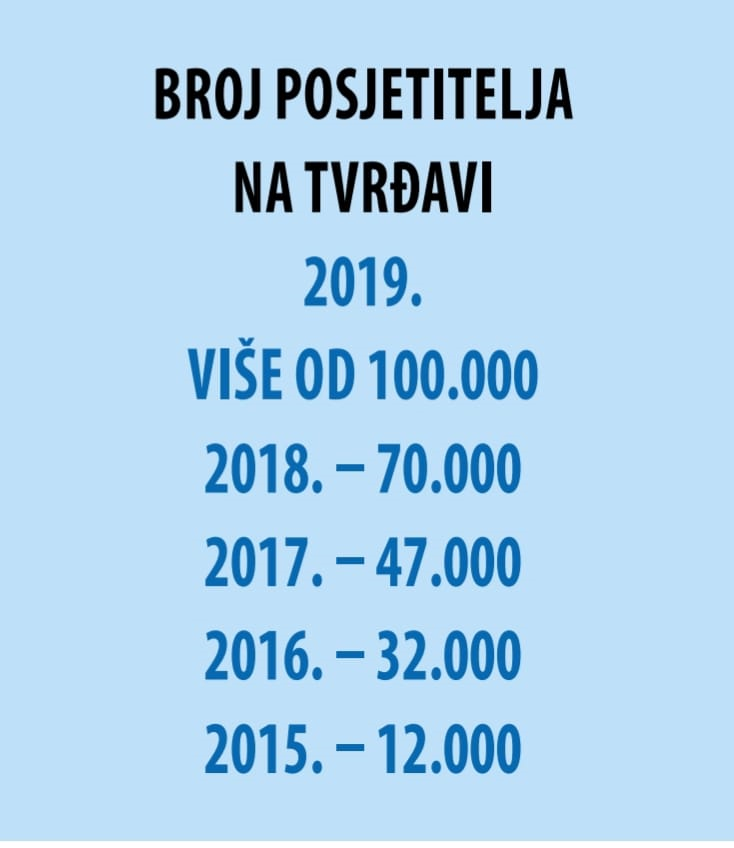
“We are investing a lot in the reconstruction of the fortress and in expanding products. Thereby we contribute not only to tourism and development of our community but the whole region. This year's ticket revenue is a record-high 5 million kuna, and part of these funds will be further invested in key infrastructure projects and demographic measures intended to improve the quality of life”, states Jakov Vetma.
![]()
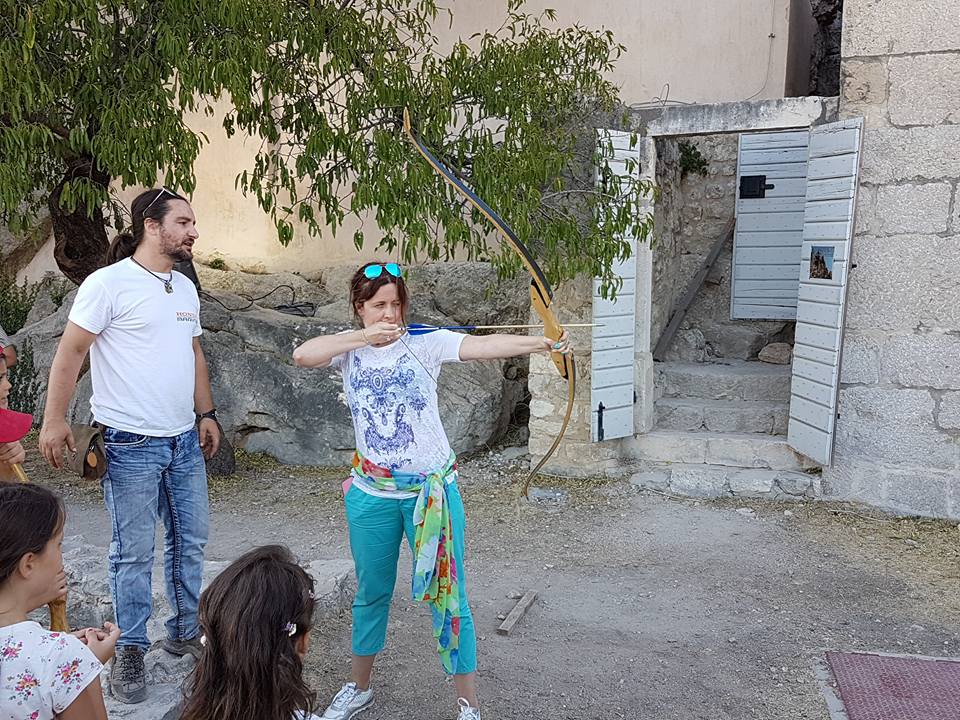
And those visitor numbers grew, and grew, and grew. Not in a mass, overtourism way that is the case elsewhere on the coast, but from a very low base to an intelligently developed attraction with content, content, content.
And content for all the family. Klis, and several other locations inland, became my top recommendation for people wanting something a little bit different (here is what you can experience on a fascinating day trip inland starting from Split). Game of Thrones might be the draw for many, but keeping the kids entertained is also a priority. And in addition to the wonderful armoury museum, there is plenty of opportunity to sharpen your archery and sword-fighting skills under expert guidance.
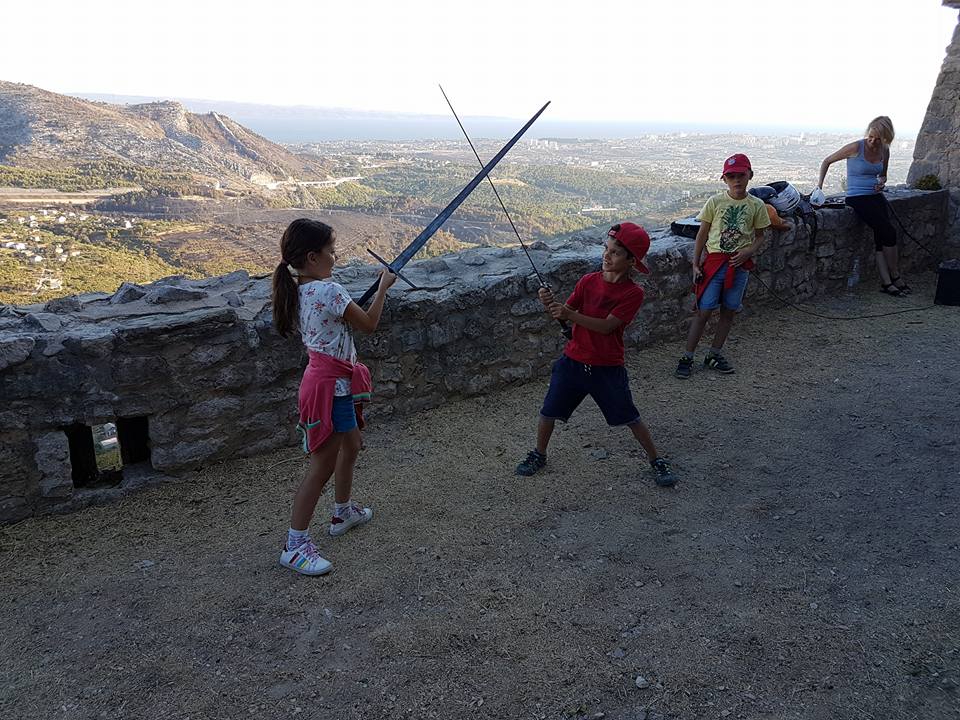
In 2019, the brand new Interpretation center, the tourist attraction worth 1 million kuna, was opened. In the centre through the 3D hologram projections, visitors can learn about extremely rich historical and cultural heritage of the area. The project also includes possibility of 3D mapping on the exterior walls of the Interpretation center, which provides attractive visual content.
Game of Thrones might be getting all the headlines, but this impressive groundwork of infrastructure and content was giving the future of Klis foundations as solid as the fortress itself. A city in the hills just outside the city. A new panoramic webcam so that people could enjoy 'the most beautiful view in Dalmatia.'
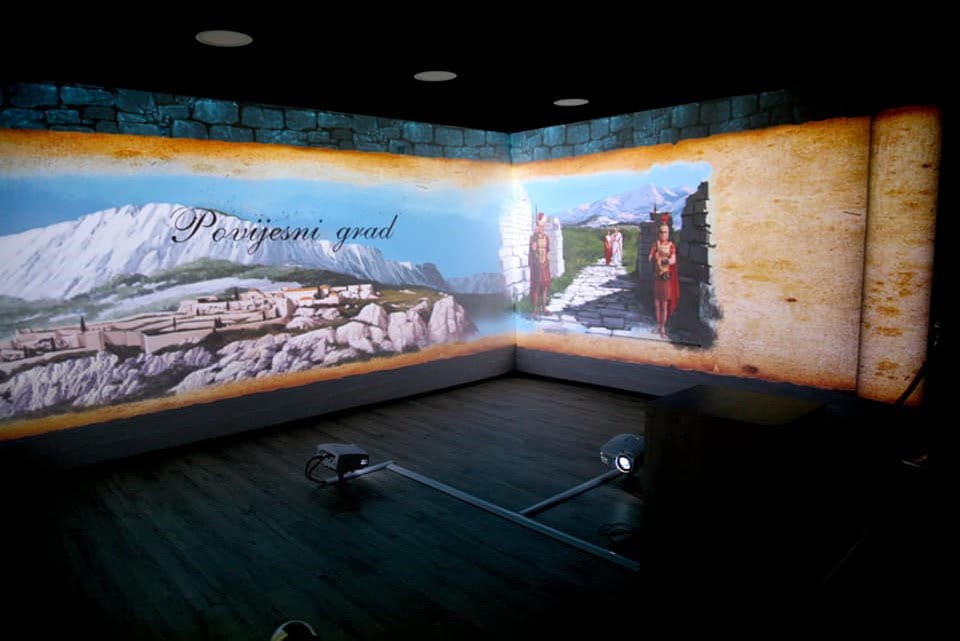
Thanks to EU funds, the fortress is currently undergoing the final works on the installation of special lighting, a project worth 2.8 million kuna, and the appearance of the fortification complex will be enhanced after the reconstruction of the two devastated buildings within the fort and the installation of a summer stage. The total value of the aforementioned works is 5.5 million kuna.
I checked my timeline from that first torchlit meeting with Mayor Vetma - 3.75 years.
And they say that things go slowly in Dalmatia...
The national media started to notice. Klis has long been popular with locals from Split as an escape from the city. Easily reachable by bus and car, Klis is also a famed culinary spot, offering some of the best lamb in Dalmatia, and there are several restaurants close to the fortress. But something else ws happening as a result of the above (and other) proactive policies of the local administration. By August 2019, the media was reporting that Klis was an increasingly desirable place to live.
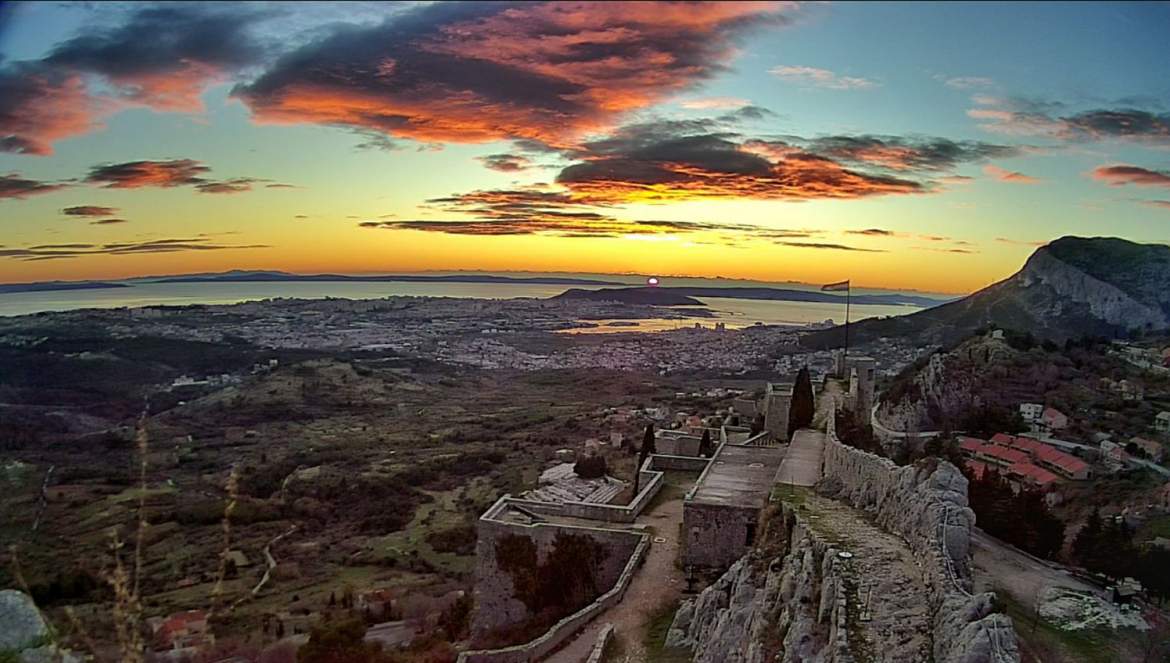
The Klis Municipality is recognised for its pro-natal policy, due to which Klis is being chosen by more and more young families with children. Of the only 58 cities and municipalities in Croatia that have a positive natural increase, Klis is one of them for the second year in a row. In order to continue this positive demographic trend, Klis is investing a range of resources directly into demographic measures. One of them was announced to help young families buy land for the construction of a family home on very favourable terms. Klis will thus be the first municipality in the Split-Dalmatia County to introduce such a measure.
With the allocation of over 3.5 million kuna, pre-school and school education for more than 500 children has been funded, and with 300 thousand kuna provided for student and student scholarships, the Municipality of Klis is further assisting 65 pupils and students. For the past two years, workbooks have been funded for all elementary students, while textbooks are provided by Split-Dalmatia County. By the beginning of the next preschool year, Klis will receive its first nursery.
The fortress may be the star attraction in Klis, but it is not the only one by any means. Another fantastic content addition has come in the form of Stella Croatica, the reason for my last visit, and a delightful family day trip for those wanting to learn more about Dalmatian nature, food and traditions - Stella Croatica.
Stella Croatica, which was crowned Croatian Rural Tourism Champion in 2018, is a multi-purpose complex offering many aspects of the traditional Dalmatian way of life. These include a Mediterranean garden with more than 500 herbs and plants; arboretum; olive and fig groves, vineyard and chef's garden; traditional Dalmatian tavern and original Dalmatian stone buildings around a village square; a factory producing traditional food products; exhibition and museum; and taste and buy option. Take a tour for yourself on the official website.
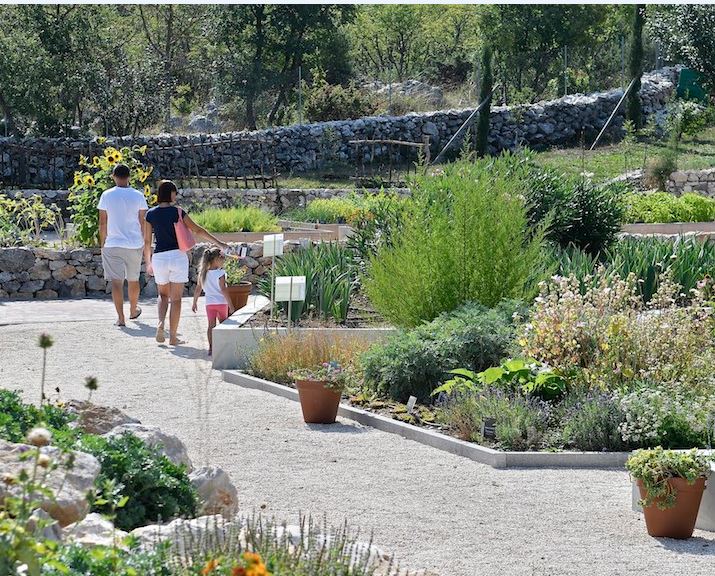
It is a really nice day out in its own right, with plenty of fun for the kids, as you can see in the video above. Combine it with all that is happening at the fortress these days, and no wonder those tourism numbers to Klis are on the rise.

Along with numerous tourism, economic and traffic predispositions, Klis is a central place of the Croatian past and the starting point of national history. Therefore, it is not surprising that mayor Jakov Vetma believes that Klis shouldn't be named a municipality, but a town. The Municipal Council and the Council of Split-Dalmatia County agree, and have even supported that petition.
“The city is made up of people, not buildings. And the important people throughout the history of our people who ruled, lived, and battled in Klis give us that right. It would also be easier to get European funding for future projects if Klis was considered a town, which would improve visibility, development and a better standard for the inhabitants”, concluded Vetma.
To follow the next chapter, follow the TCN news from Klis.
Klis Fortress Logs This Year's 100,000th Visitor
ZAGREB, November 3, 2019 - The Klis Fortress logged this year's 100,000th visitor on October 29, 51% more visitors than at the same time in 2018, and this year's ticket revenue is a record-high 5 million kuna, according to the information provided by the authorities of Klis Municipality overlooking the City of Split.
Municipal head Jakov Vetma said the municipality was "investing a lot in the reconstruction of the fortress and in expanding products. Thereby we contribute not only to tourism and development of our community but the whole region."
Klis Fortress is one of Europe's most important and most beautiful fortresses and its cultural heritage deserves to be properly promoted for tourism, he said.
Part of the money made from tickets will be invested in key infrastructure projects and population measures intended to improve the quality of life, Vetma said.
The fortress stands on the steep cliffs of the gorge between Kozjak and Mosor mountains.
"It was built on an extraordinary strategic location that allows military and commercial control over the whole Klis valley and the area of Salona and Split. Because of its importance, Klis was often referred to as the key to Dalmatia and the heart of the medieval Croatian kingdom," according to the information available on the Kliss Fortress website.
"Klis’s greatest significance for Croatian history dates back to the 15th century when it found itself at the crossroads of the three empires – the Ottoman Empire, the Venetian Republic and the Habsburg Monarchy. Klis was the home of the Uskoks, military units that got their name because they jumped into („uskočiti“ in Croatian) the enemy territory, pillaged it and returned to their base. The leader of the Klis Uskoks was Petar Kružić, who defended the fortress with his men for more than twenty years against powerful Ottoman army. Nevertheless, with very poor help from the Habsburg ruler Klis could not resist forever, and in 1537 it fell into Turkish hands."
The fortress had its last major role in the military sense during the War of Candia between the Venetian Republic and the Ottoman Empire. In the end fell into the hands of the Venetian army in which many Croatians were conscripted. "From that point on, Klis will no longer see larger military action beneath its walls – it remains in Venetian hands until 1797 when it comes under the French rule. By the fall of the First French Empire fortress became part of the Habsburg Monarchy, and with its abolishment it shared the fate of Croatian territories until 1990, when the flag of Republic of Croatia was flown over it," according to the history of this landmark of the Split hinterland.
More Klis news can be found in the Lifestyle section.
Eight Summer Stages in Split Area to Revitalize Cultural Heritage
September 5, 2019 - Eight summer stages in the Split area, worth 27.8 million kuna, will provide additional facilities for locals and tourist attractions.
On September 3, 2019, Minister of Regional Development and EU Funds Marko Pavic decided to finance the ITU strategic project "Open Summer Stages of the Urban Agglomeration of Split", which provides a non-refundable HRK 27.8 million from the ITU mechanism.
The project will revitalize cultural heritage and will provide additional facilities for locals and tourist attractions through the construction, renovation, and furnishing of outdoor summer stages at eight different locations. The construction, renovation and furnishing of the open summer stages, accompanying facilities and facilities for cultural and tourist purposes, will be carried out at the following locations in the cities of Solin, Trogir, Kastela and Omis and the municipalities of Klis, Dugopolje and Lecevica:
• Solin: renovation of Gradina, stage construction;
• Solin: renovation and construction of the Cultural Information Center and renovation of the square;
• Klis: remodeling two buildings and repairing the walls of Klis Fortress, 3D mapping, stage construction;
• Omis: renovation of the “Old Cemetery”, stage construction;
• Dugopolje: the summer stage near the church of Sv. Rocco;
• Kastela: renovation of the Dudan Park in Kastel Kambelovac, stage construction;
• Lecevica: renovation of the old wells in the village of Radosic, stage construction;
• Trogir: summer stage in the old town.
The project will increase the level of preservation and landscaping of these attractions, and modernize the existing facilities, while raising the quality of the cultural heritage and its long-term and sustainable use for the inhabitants of the Urban Agglomeration of Split and all visitors to the area.
The success of the project is based on the identification, activation and cooperation of local development potential with an emphasis on the efficient use of resources in planning and managed development in the area of Urban agglomeration Split.
Recall, this news comes after the City of Split has announced a competition for a new multipurpose hall for cultural and social content, which will be located in the city center. The hall should begin operating in the 2020/2021 season. The process began Monday through public consultation, according to the City.
The hall is designed as a multipurpose hall and will be able to hold cinema screenings, theater performances, cultural and musical events, conferences and congresses. It will have an independent entrance via the main staircase from the outer space, it will be accessible to disabled people and persons with reduced mobility, and will boast a capacity of 168 seats.
To read more about lifestyle in Croatia, follow TCN's dedicated page.
Klis Municipality Becoming More and More Desirable Place to Live
As Poslovni Dnevnik writes on the 13th of August, 2019, for the Municipality of Klis, the former seat of the Croatian kings just above Split, the past year has been one of the most successful ones since its inception.
Thanks to the rise of tourism in the area, a series of completed infrastructural interventions and the start of new ones, as well as the beginning of some brand new projects have been being realised in this small municipality above Split with just over 5000 inhabitants in 14 settlements, and an extremely costly project is being implemented today.
The Klis Municipality is recognised for its pro-natal policy, due to which Klis is being chosen by more and more young families with children. Of the only 58 cities and municipalities in Croatia that have a positive natural increase, Klis is one of them for the second year in a row.
In order to continue this positive demographic trend, Klis is investing a range of resources directly into demographic measures. One of them was announced to help young families buy land for the construction of a family home on very favourable terms. Klis will thus be the first municipality in the Split-Dalmatia County to introduce such a measure.
With the allocation of over 3.5 million kuna, pre-school and school education for more than 500 children has been funded, and with 300 thousand kuna provided for student and student scholarships, the Municipality of Klis is further assisting 65 pupils and students. For the past two years, workbooks have been funded for all elementary students, while textbooks are provided by Split-Dalmatia County.
By the beginning of the next preschool year, Klis will receive its first nursery. The value of the project stands at 400 thousand kuna, and by the beginning of the new school year, the elementary school in Prugovo will also be renovated. The abandoned sports ground in Brocanac has already been renovated with 200,000 kuna, while the Municipality of Klis, in cooperation with the Soline Red Cross, has also arranged and equipped a children's playground at the same location.
As a further step in stimulating parenting, the Municipality of Klis also plans to introduce a parental educator institute. This is an added benefit that unemployed parents with four or more minor children who do not attend kindergarten will be able to receive.
In recent years, Klis has seen great results owing to tourism, the development of which is mostly tied to the Klis Fortress, a cultural and historical monument of inestimable value, which has gained worldwide glory thanks to HBO's "Game of Thrones" series.
Last year's record of 70,000 visitors and revenues of just over 3 million kuna have already been surpassed this year. With an already generated 5 million kuna in revenue, it is expected that over 100,000 tourists will visit the fort by the end of the season.
Currently, the fortress is undergoing the final works on the installation of special lighting, a project worth 2.8 million kuna, and the appearance of the fortification complex will be enhanced after the reconstruction of the two devastated buildings within the fort and the installation of a summer stage or 3D mapping theatre. The total value of the aforementioned works is 5.5 million kuna.
Back at the end of May, at the foot of the fortress, a new interpretation centre, a project worth 1 million kuna in total, was opened, offering innovative simulations of the long and rich history of Klis to its visitors, as well as an overview of the entire Klis tourist offer through innovative 3D technology. In the near future, a souvenir shop will be opened in the very centre of the town, which will, among other things, offer authentic products from local OPGs.
One of the most significant projects for Klis is the construction of a sewage system and the water supply reconstruction in the wider Klis area. Besides that, the construction of the Vučevica tunnel, one of the most important projects for the future of the municipality, which is planned in cooperation with the Ministry of Maritime Affairs, Transport and Infrastructure and Split-Dalmatia County, will create the preconditions for the revitalisation of the Dalmatian hinterland (zagora).
Make sure to follow our dedicated lifestyle page for much more.


